Student Research Symposium Program Portal
99 submissions
| # | SID | Presentation Modality | Poster Session/Number | Submission title | UUID | In draft | Starred | Locked | Notes | Created | Completed | Changed | User | IP address | Primary Student Contact First Name | Primary Student Contact Last Name | Pronouns | Primary Student Contact FSU Student Email | Photo of all individuals presenting this work | Major(s) of all individuals presenting this work | Bio of all individuals presenting this work | Poster Title | Abstract | Research Mentor Name | Research Mentor's College (or High School) | Research Mentor's Department (or Subject) | Research Mentor's Email | Additional Research Mentor(s) | Co-presenter(s) | Keywords | Work | Poster PDF | Poster Thumbnail | I will be printing my poster | Year | Annual description | Update URL | Operations |
|---|---|---|---|---|---|---|---|---|---|---|---|---|---|---|---|---|---|---|---|---|---|---|---|---|---|---|---|---|---|---|---|---|---|---|---|---|---|---|
| 60 | 7831 | Synchronous Online Presentation | https://pc.fsu.edu/student-research/symposium/symposium-program-2025/dnap | Student Research Symposium Program Portal: Submission #60 | 7263ad3a-b2ba-4ad7-9e6d-193897a10969 | No | Star/flag Student Research Symposium Program Portal: Submission #60 | Lock Student Research Symposium Program Portal: Submission #60 | Add notes to Student Research Symposium Program Portal: Submission #60 | Wed, 02/05/2025 - 05:50 PM | Wed, 02/05/2025 - 06:03 PM | Tue, 04/01/2025 - 08:26 AM | Anonymous | 97.112.203.198 | Luke | Gunter | Lg22j@fsu.edu |
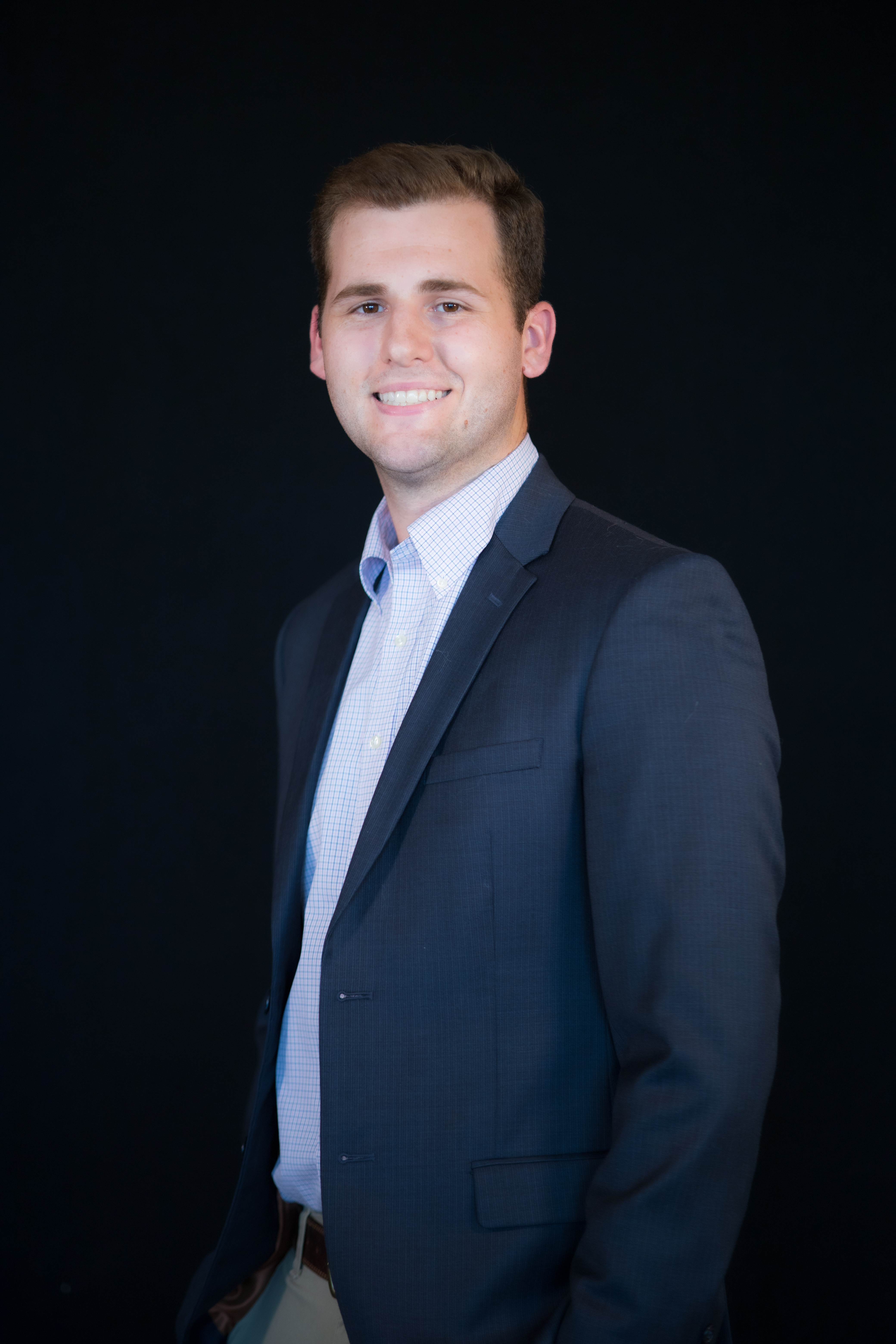
|
Doctor of Nurse Anesthesia Practice | My name is Luke Gunter. I am from Dothan, Alabama. I will happily be graduating with my DNAP in May, 2025 and will start my anesthesia career in Dothan. | Dexmedetomidine for Reducing Opioid use in Laparoscopic Procedures | Most people who are going to undergo a surgical procedure want to receive the best treatment possible. Desirable outcomes are always having as little pain as possible, getting back home as quickly as possible, and not having much nausea or other adverse effects. Some of these adverse effects could be from the surgery itself but also could be from the anesthesia provided. For this reason, it is critical that anesthesia providers know the best anesthesia practices to facilitate the best treatment for their patients. This paper aims to show the efficacy of dexmedetomidine in patients undergoing laparoscopic surgery to increase satisfaction with some of these desired effects, as mentioned above. These benefits and effects lead to the discussion of the PICO question: Do adult patients who have laparoscopic procedures (P) who receive dexmedetomidine during the perioperative period (I) have lower pain scores in the PACU (O) compared to adult patients having laparoscopic procedures who do not receive dexmedetomidine (C)? Utilizing this question, a focused literature search was conducted and found that it is statistically significant that dexmedetomidine does cause a reduction in the use of opioids, which helps facilitate faster recovery times, less pain after surgery, and less nausea and vomiting. This information was provided and shared with anesthesia providers at a hospital in the South East area. This hospital already had a strong basis of knowledge regarding dexmedetomidine and already used the drug frequently. There was not any statistically significant increase in the use of dexmedetomidine during laparoscopic cases. | Gerard Hogan | Florida State University | Director of Research – Nurse Anesthesia Program | ghogan@pc.fsu.edu | Branden Schorr | Dexmedetomidine, Laparoscopic procedures, Opioids | Complete | Yes | 2025 | 5th annual Undergraduate Research Symposium, April 17, 2025 | https://pc.fsu.edu/student-research/symposium/research-symposium-program-portal?element_parents=elements/student_photo&ajax_form=1&_wrapper_format=drupal_ajax&token=4mp0H7Z8aB_cKEw5PZURzdtoUZrsQoS69sKBzmh-CI8 | |||||
| 59 | 7826 | Synchronous Online Presentation | https://pc.fsu.edu/student-research/symposium/symposium-program-2025/dnap | Student Research Symposium Program Portal: Submission #59 | b773dc6b-b9fa-41ca-9b60-3cb0d9e5a6bd | No | Star/flag Student Research Symposium Program Portal: Submission #59 | Lock Student Research Symposium Program Portal: Submission #59 | Add notes to Student Research Symposium Program Portal: Submission #59 | Wed, 02/05/2025 - 05:43 PM | Wed, 02/05/2025 - 05:52 PM | Tue, 04/01/2025 - 08:29 AM | Anonymous | 129.222.87.7 | Cameron | Moore | cjm22s@fsu.edu |
|
DNAP- Nurse Anesthesia | Hello, my name is Cameron Moore. My research partner, Ethan Stanley, and I performed our DNAP project on the education of Gastric Point-of-care ultrasound (POCUS). We researched and implemented education regarding Gastric POCUS at one of our main clinical sites in Dothan, Alabama. Ethan and I are both from the Dothan area and worked at the same hospital before attending CRNA school. We plan to stay in the surrounding area and work in local hospitals after graduating from anesthesia school. | Perioperative Gastric Point of Care Ultrasound | Gastric point of care ultrasound (POCUS) is a resource that can be utilized perioperatively at the bedside to assess the patient's residual gastric volume to assist with guiding the anesthetic plan. With comorbidities such as diabetes and gastroparesis, as well as the increasing demand for GLP-1 agonists, POCUS is an invaluable tool for the anesthesia provider to assess for liquid and solid gastric content preoperatively. The purpose of this paper is to demonstrate there is a lack of provider knowledge in how to adequately perform and interpret results of a gastric POCUS exam. The following PICO question was used to search various databases and guide the practice improvement project: Do anesthesia providers (P) who receive a structured educational program in POCUS (I) show increased knowledge in gastric content scanning preoperatively (O)? A critical appraisal of four studies showed that the utilization of gastric POCUS is a safe and effective bedside resource with very minimal complications. This paper explains the advantages and methods of gastric ultrasound that can be incorporated into deciding the safest anesthetic plan. Data was collected via a pre and post-educational intervention exam. The project team found a significant increase in provider knowledge after POCUS education was conducted. | Lonnie W. Hodges, DNP, CRNA, CHSE, Lt. Col USAF | Florida State University- PC | DNAP Anesthesia | lwhodges@pc.fsu.edu | Stacey A. VanDyke, DNP, APRN, FAANA, CRNA | Ethan Stanley | Gastric POCUS, GLP-1 Agonist, Gastric Ultrasound | Complete | Poster PDF.pdf378.77 KB
|
No | 2025 | 5th annual Undergraduate Research Symposium, April 17, 2025 | https://pc.fsu.edu/student-research/symposium/research-symposium-program-portal?element_parents=elements/student_photo&ajax_form=1&_wrapper_format=drupal_ajax&token=HziRhSXQKdaENGXeeLbxWQd01U3WJuu2xSghqlezk1A | |||
| 58 | 7821 | Synchronous Online Presentation | https://pc.fsu.edu/student-research/symposium/symposium-program-2025/dnap | Student Research Symposium Program Portal: Submission #58 | 73ce831f-6177-4d54-9ac2-35897a059ba4 | No | Star/flag Student Research Symposium Program Portal: Submission #58 | Lock Student Research Symposium Program Portal: Submission #58 | Add notes to Student Research Symposium Program Portal: Submission #58 | Wed, 02/05/2025 - 05:19 PM | Wed, 02/05/2025 - 05:29 PM | Tue, 04/01/2025 - 08:31 AM | Anonymous | 67.146.133.52 | Cheyenne | Sapp | ccs22c@fsu.edu |
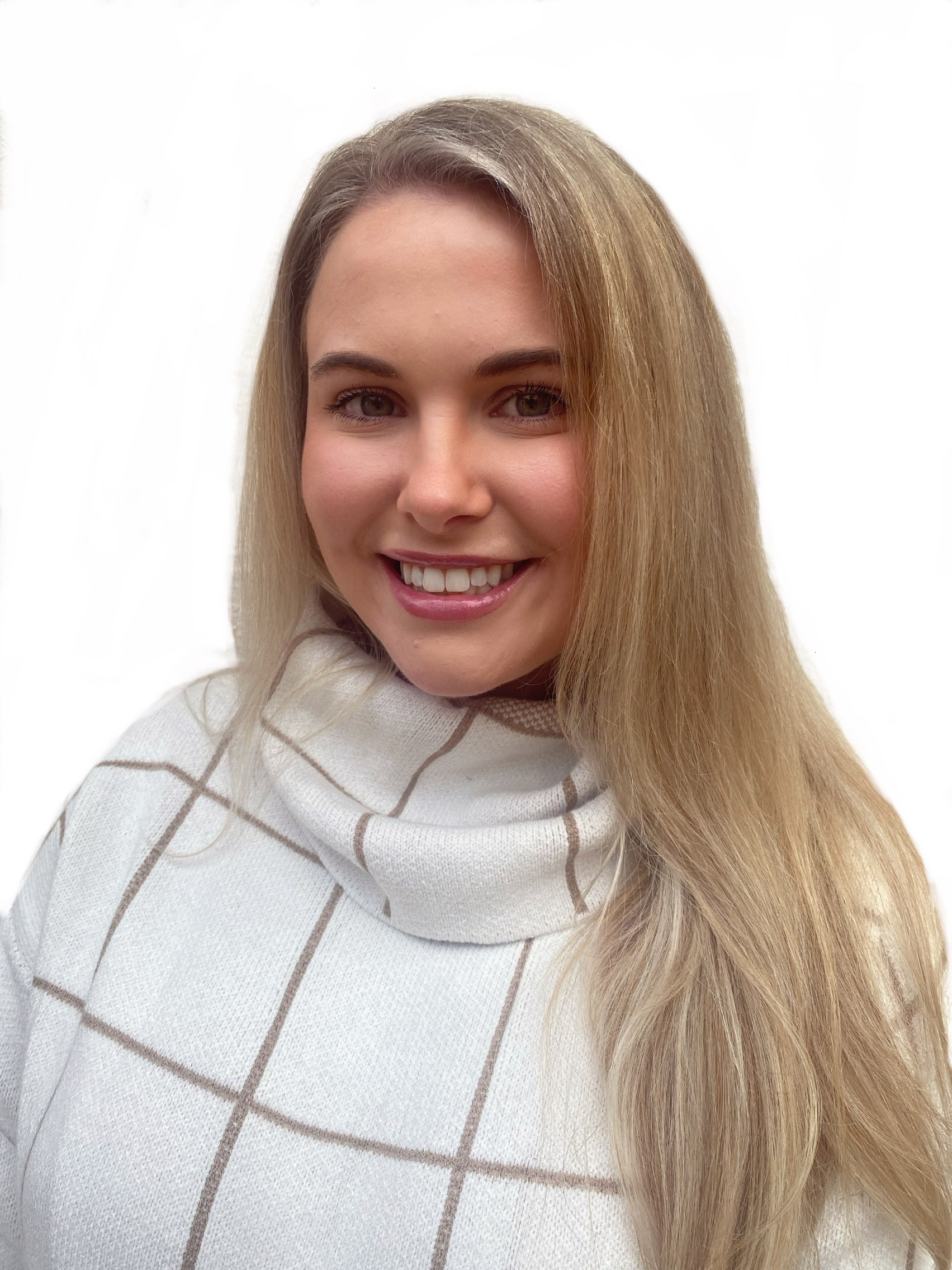
|
Doctorate of Nurse Anesthesia Practice | I am a student in the Class of 2025- Doctor of Nurse Anesthesia Practice at Florida State University. I am passionate about the practice of anesthesia and furthering evidence based practice through research. I plan to practice in my hometown of Dothan, Alabama upon graduation. | Post-Anesthesia Care Unit Times in Patients Reversed from Aminosteroid Paralytics with Sugammadex versus Neostigmine and Glycopyrrolate Combination | Neuromuscular blockade (NMB) reversal is vital for anesthesia care to prevent residual blockade, which can lead to respiratory complications and delayed recovery. This quality improvement project evaluated sugammadex, a selective NMB reversal agent, compared to the traditional neostigmine-glycopyrrolate, focusing on postoperative care unit (PACU) times in adult patients undergoing general anesthesia with rocuronium or vecuronium. Evidence from clinical guidelines and studies supported sugammadex's advantages in efficiency, safety, and cost-effectiveness. Implemented at a facility in Dothan, Alabama, the project addressed financial concerns through education, aiming to increase sugammadex utilization. Usage increased modestly by 1.38% (from 434 to 440 cases), reflecting improved provider confidence and highlighting the value of overcoming barriers to enhance patient safety and operating room efficiency. | Dr. Jason Smith, DNAP, APRN, CRNA | Florida State University | Nurse Anesthesia | jcsmith3@fsu.edu | Shelby Ragan, SRNA | Reversal, Neostigmine, Glycopyrrolate, Sugammadex | Complete | DNAP Poster .pdf503.28 KB
|
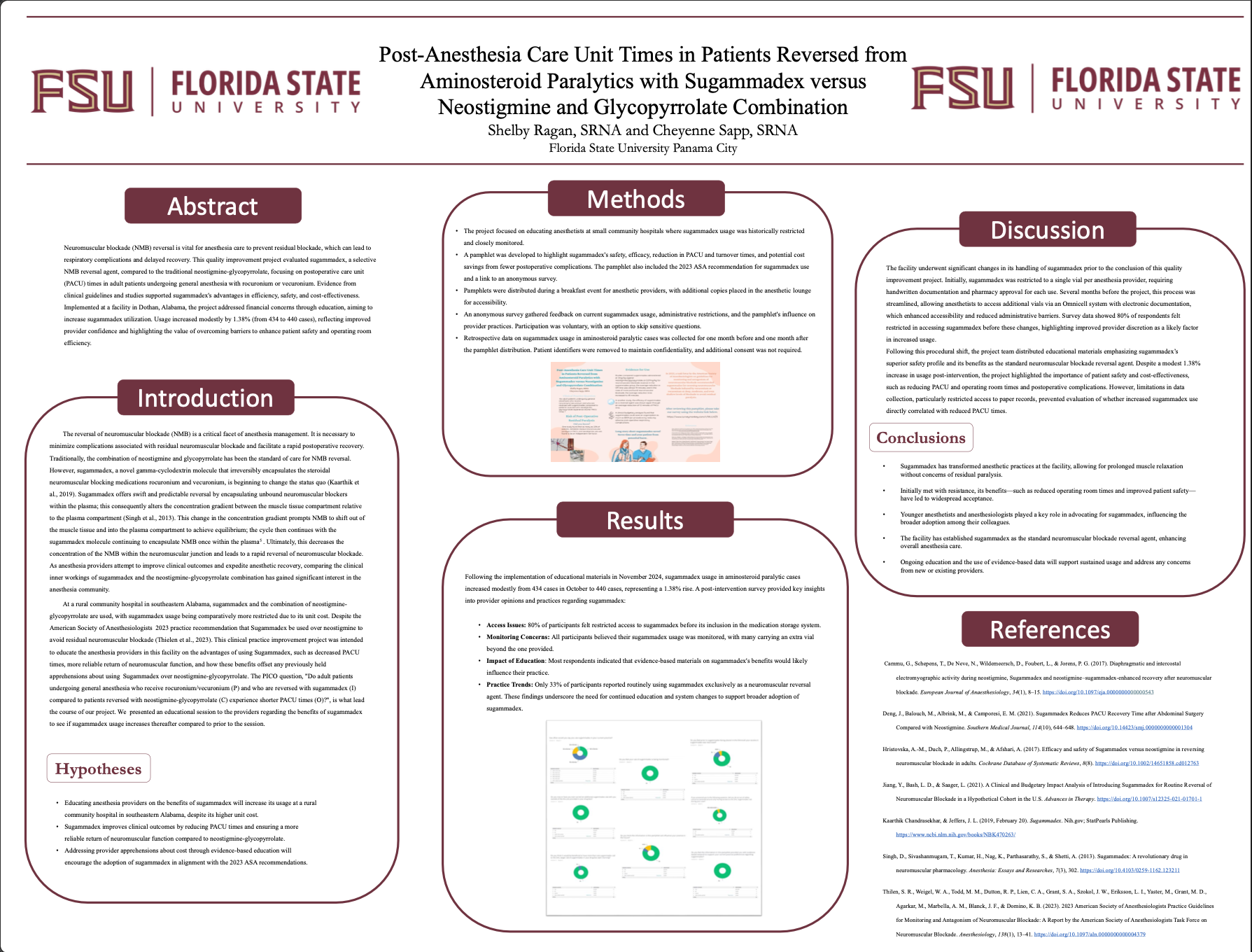
|
No | 2025 | 5th annual Undergraduate Research Symposium, April 17, 2025 | https://pc.fsu.edu/student-research/symposium/research-symposium-program-portal?element_parents=elements/student_photo&ajax_form=1&_wrapper_format=drupal_ajax&token=cNNwtN9MQPBijnLDxmJEPojdtQqGPmh1arTgdDquD80 | |||
| 57 | 7811 | Synchronous Online Presentation | https://pc.fsu.edu/student-research/symposium/symposium-program-2025/dnap | Student Research Symposium Program Portal: Submission #57 | 3e1e9200-ef0a-4b4a-aa70-8957423f88c5 | No | Star/flag Student Research Symposium Program Portal: Submission #57 | Lock Student Research Symposium Program Portal: Submission #57 | Add notes to Student Research Symposium Program Portal: Submission #57 | Wed, 02/05/2025 - 10:27 AM | Wed, 02/05/2025 - 10:49 AM | Tue, 04/01/2025 - 08:40 AM | Anonymous | 142.197.114.198 | Kendra | Secrest | krs13k@fsu.edu |
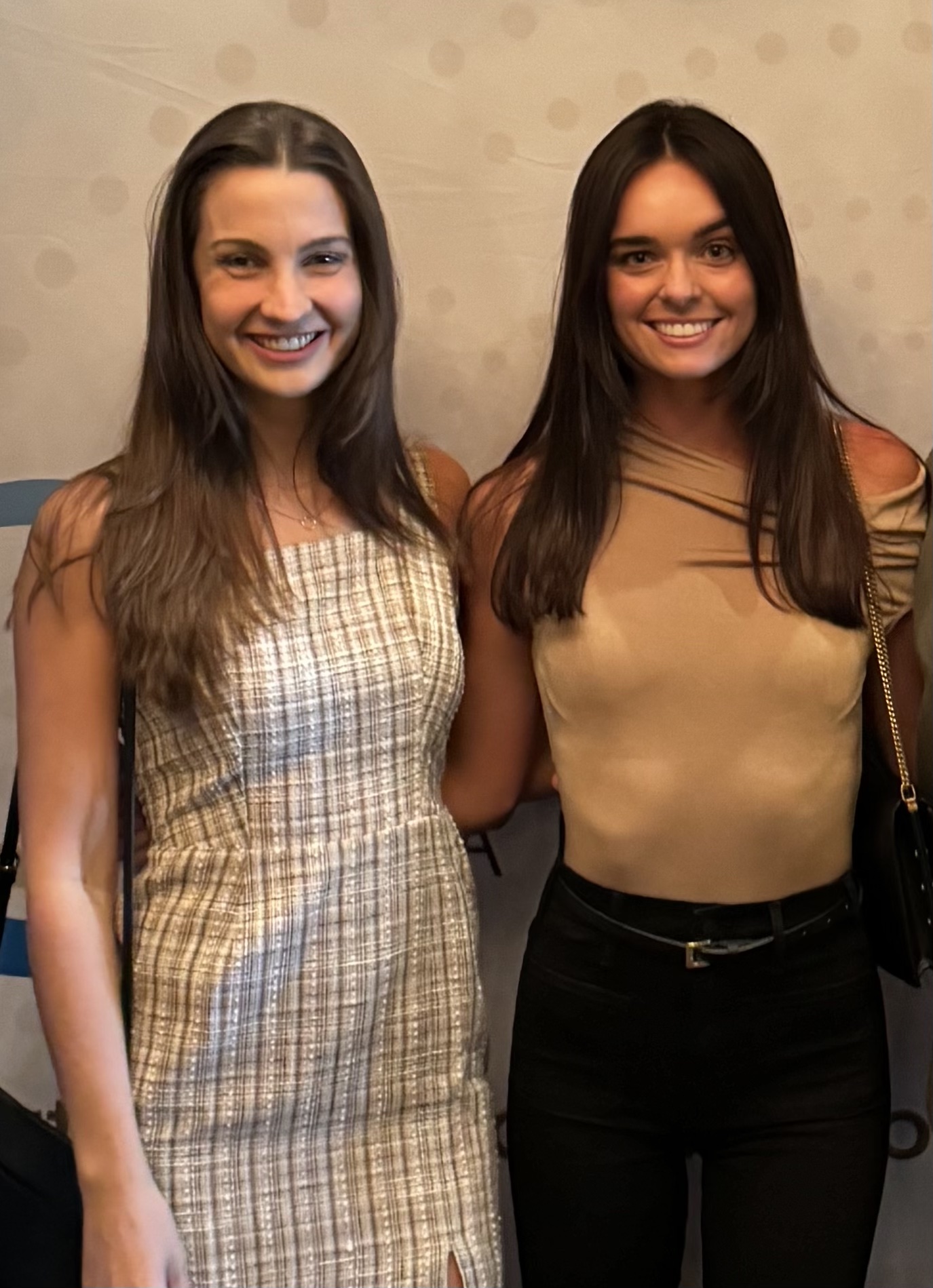
|
Doctor of Nurse Anesthesia Practice | Before pursing her degree in Nurse Anesthesia, Kendra spent most of her 5 years as a nurse working in the cardiothoracic intensive care unit. In school, she continues to have a strong passion for caring for cardiac surgical patients and hopes to provide cardiac anesthesia after graduation. Research interests include ways to optimize patient care through improving the quality and effectiveness of healthcare delivery. | Does employing single-use translucent eye patches for eye protection in adult patients undergoing general anesthesia as opposed to reusing the same roll of tape across multiple patients decrease the possibility of infection? | During general anesthesia, the patient's eyes must be protected to prevent corneal abrasions (Grixti et al., 2013). Several approaches are used to ensure that the eyelids remain closed during surgery including medical tape, transparent film, and single-use eye covers. There is no standard of care that delineates the superiority of one method of protection over another, as long as the eyelids remain closed, and the eyes are protected from external insult. Prior to the implementation of this project, the most commonly used method of eye protection at a large teaching hospital in central Florida was medical tape, likely due to its low cost, ease of use, and widespread availability throughout the hospital. Multi-use medical tape, however, carries an increased risk of healthcare acquired infections owing to the fact that it is almost never washed or sterilized after opening, is exposed to many patients and clinicians, and it is used to secure invasive lines, drains, and airways, and wound dressings. The purpose of this paper is to highlight medical tape’s role in microbial transmission and to advocate for a simple practice change among anesthesia providers that reduces risk and promotes improved hygiene for patients. The following PICO question was used to search literature databases and guide the process improvement project: Does employing single-use translucent eye patches (I) for eye protection in adult patients undergoing general anesthesia (P) as opposed to reusing the same roll of tape (C) across multiple patients decrease the possibility of infection (O)? |
Gerard Hogan | Florida State University | Nurse Anesthesia | ghogan@pc.fsu.edu | Stacey VanDyke, Scott Stewart | Morgan Cook | “eye protection under general anesthesia” and “medical tape and bacterial transmission” | Complete | CookSecrestPoster_0.pdf1.45 MB
|
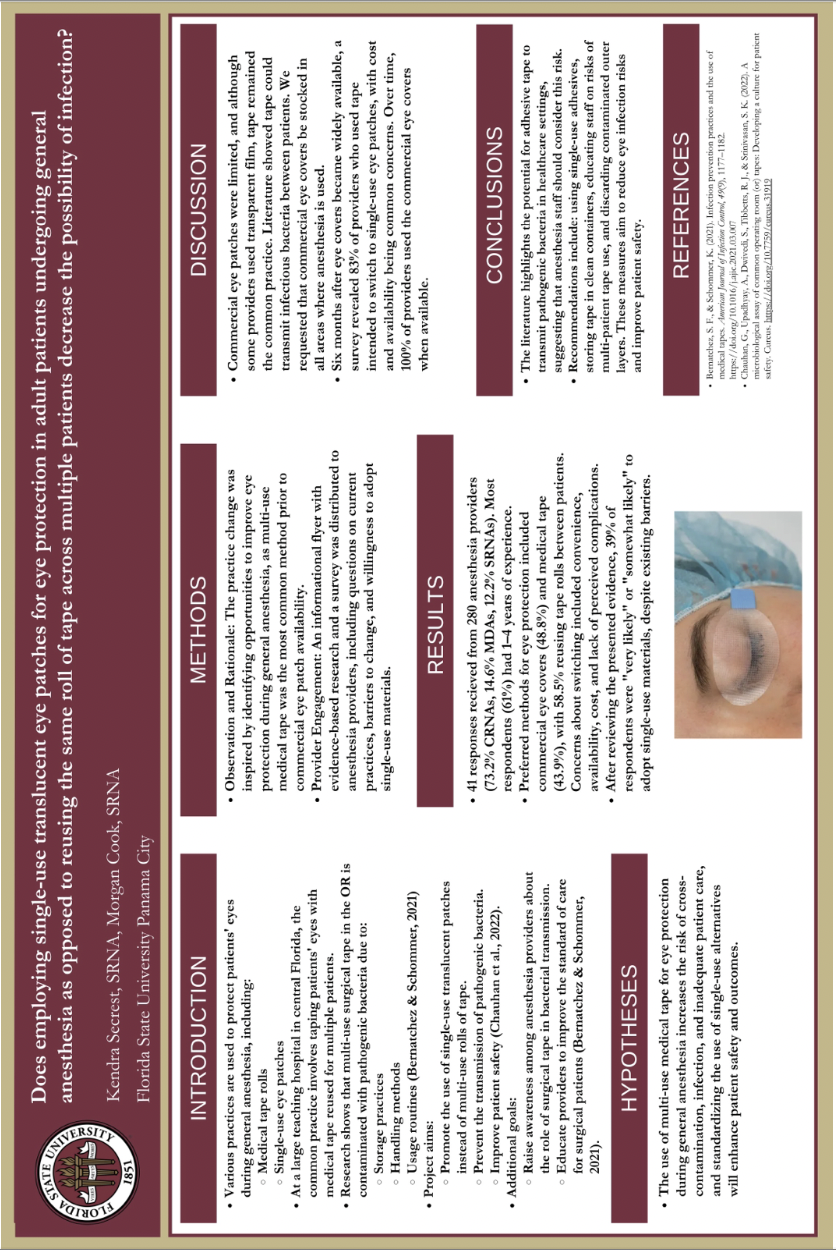
|
No | 2025 | 5th annual Undergraduate Research Symposium, April 17, 2025 | https://pc.fsu.edu/student-research/symposium/research-symposium-program-portal?element_parents=elements/student_photo&ajax_form=1&_wrapper_format=drupal_ajax&token=m7XMu7b3yAmrAzl0Ae9RiBFwUeh3JrdwRoz18AhOzIQ | ||
| 55 | 7791 | Synchronous Online Presentation | https://pc.fsu.edu/student-research/symposium/symposium-program-2025/dnap | Student Research Symposium Program Portal: Submission #55 | 10687788-75ad-490c-819b-13c2549c023d | No | Star/flag Student Research Symposium Program Portal: Submission #55 | Lock Student Research Symposium Program Portal: Submission #55 | Add notes to Student Research Symposium Program Portal: Submission #55 | Tue, 02/04/2025 - 09:02 PM | Tue, 02/04/2025 - 09:15 PM | Wed, 04/16/2025 - 11:40 AM | Anonymous | 68.1.113.177 | Michelle | Benjamin | mmm22d@fsu.edu |
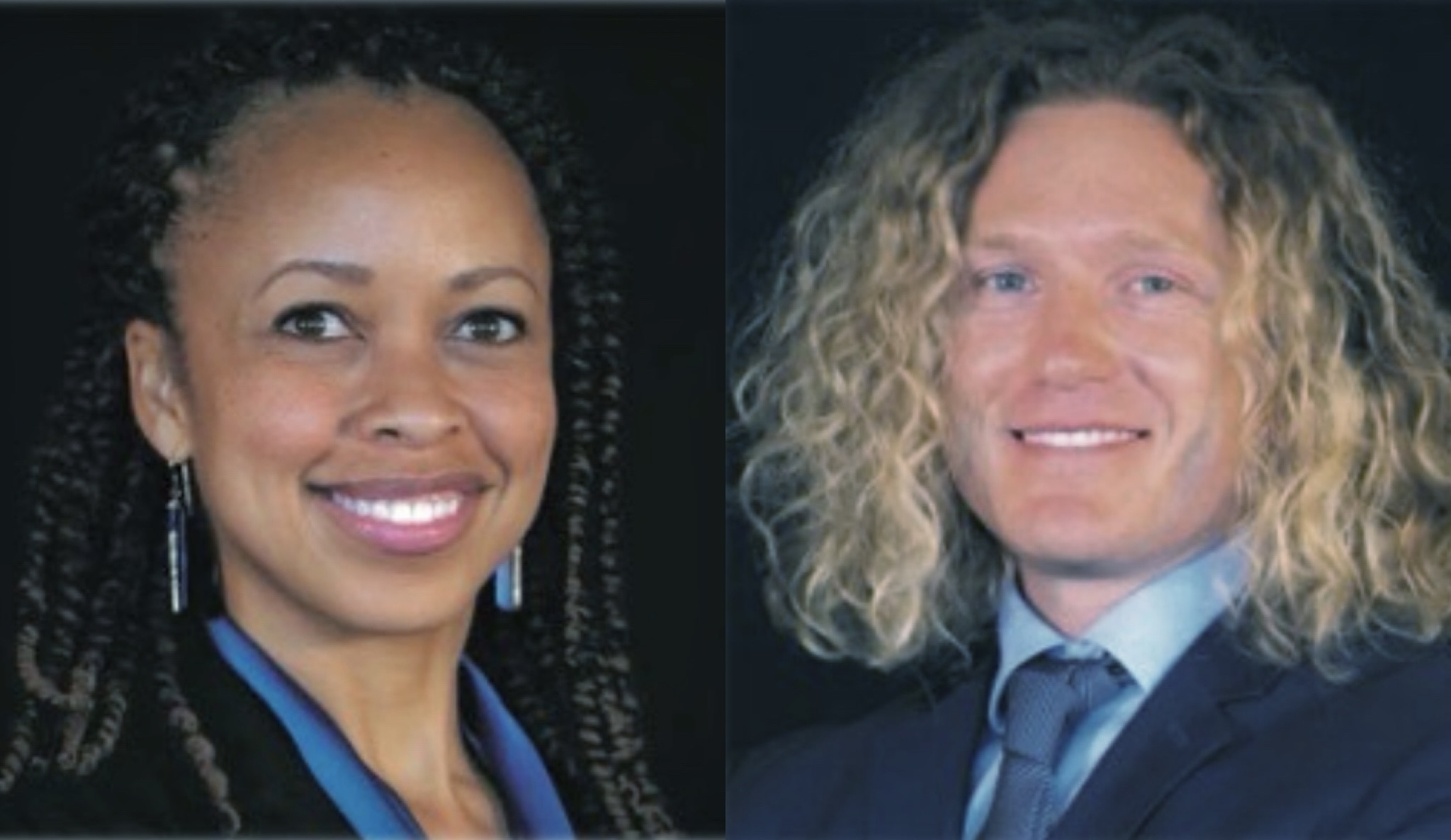
|
Doctorate of Nurse Anesthesia Practice | Michelle Benjamin and Joshua Castle are aspiring Certified Registered Nurse Anesthetists (CRNAs). | Sustaining Best Practice: Revisiting Endotracheal Tube Cuff Pressure Assessment Methods in Anesthesia Providers | Endotracheal tube cuff pressure plays a critical role in preventing complications such as aspiration, mucosal injury, and post-operative sore throat in patients undergoing anesthesia. Maintaining an optimal cuff pressure of 20-30 cmH2O is essential to avoid adverse outcomes; however, common inflation techniques often lead to inaccurate pressure levels. This project aims to assess the impact of anesthesia provider education and the use of manometers on endotracheal tube cuff pressure management at a trauma center in the Florida Panhandle. The study compares cuff pressures before and after the distribution of manometers and educational interventions aimed at improving cuff pressure monitoring. Previous data collected at the site indicated an average cuff pressure of 54 cmH2O with 89.7% of endotracheal tube cuff pressures falling outside the recommended range. A convenience data collection method was employed to assess cuff pressures in adult surgical patients, documenting variables such as provider experience and endotracheal tube size. Results were analyzed against prior data to evaluate the effectiveness of these practice changes in achieving optimal cuff pressures. New data determined an average cuff pressure of 70 cmH2O with 87% of endotracheal tube cuff pressures falling outside of the recommended range. The findings highlight the importance of education, manometer use, and documentation in improving patient outcomes, with implications for sustained quality improvement in anesthesia practice. | Scott Stewart, DNAP, CRNA | University of Tennessee at Chattanooga | Nurse Anesthesia | sstewart3l@pc.fsu.edu | Dr. Gerard Hogan | Joshua Castle | Manometer, Endotracheal Tube, Cuff Pressure | Complete | DNAP ETT CIP Project Poster.pdf359.59 KB
|
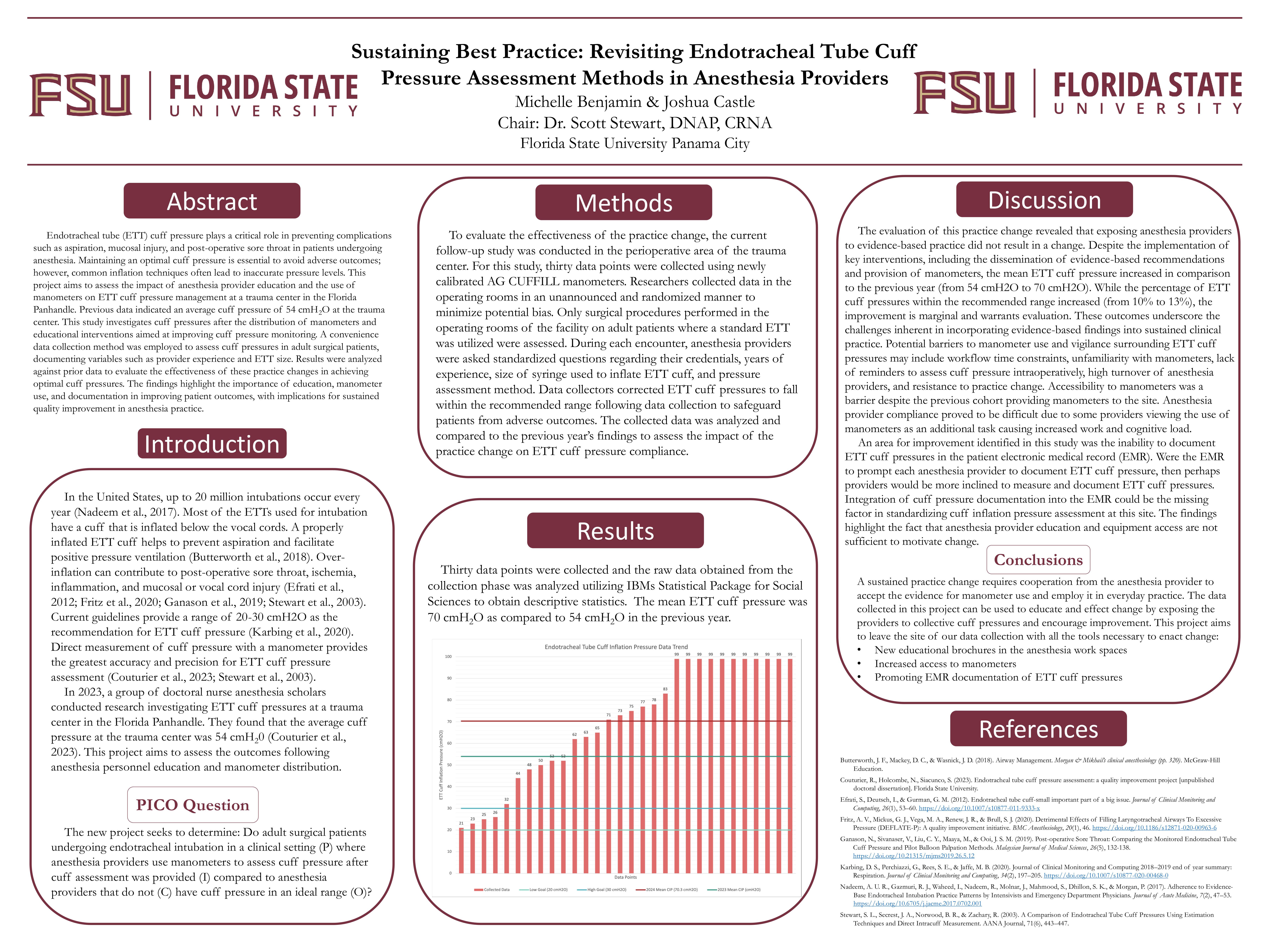
|
No | 2025 | 5th annual Undergraduate Research Symposium, April 17, 2025 | https://pc.fsu.edu/student-research/symposium/research-symposium-program-portal?element_parents=elements/student_photo&ajax_form=1&_wrapper_format=drupal_ajax&token=EJ8QShTzQ7h9fVHfgtNJMQJ-ksmQatI42KWZta-OEV0 | ||
| 54 | 7786 | Asynchronous Online Presentation | https://pc.fsu.edu/student-research/symposium/symposium-program-2025/systems-engineering | Student Research Symposium Program Portal: Submission #54 | d0d7d517-e02d-49da-b849-ad9d0789f2a2 | No | Star/flag Student Research Symposium Program Portal: Submission #54 | Lock Student Research Symposium Program Portal: Submission #54 | Add notes to Student Research Symposium Program Portal: Submission #54 | Tue, 02/04/2025 - 03:13 PM | Tue, 02/04/2025 - 03:14 PM | Tue, 04/01/2025 - 07:21 AM | Anonymous | 107.116.180.36 | Colin | Fortner | crf13@fsu.edu |
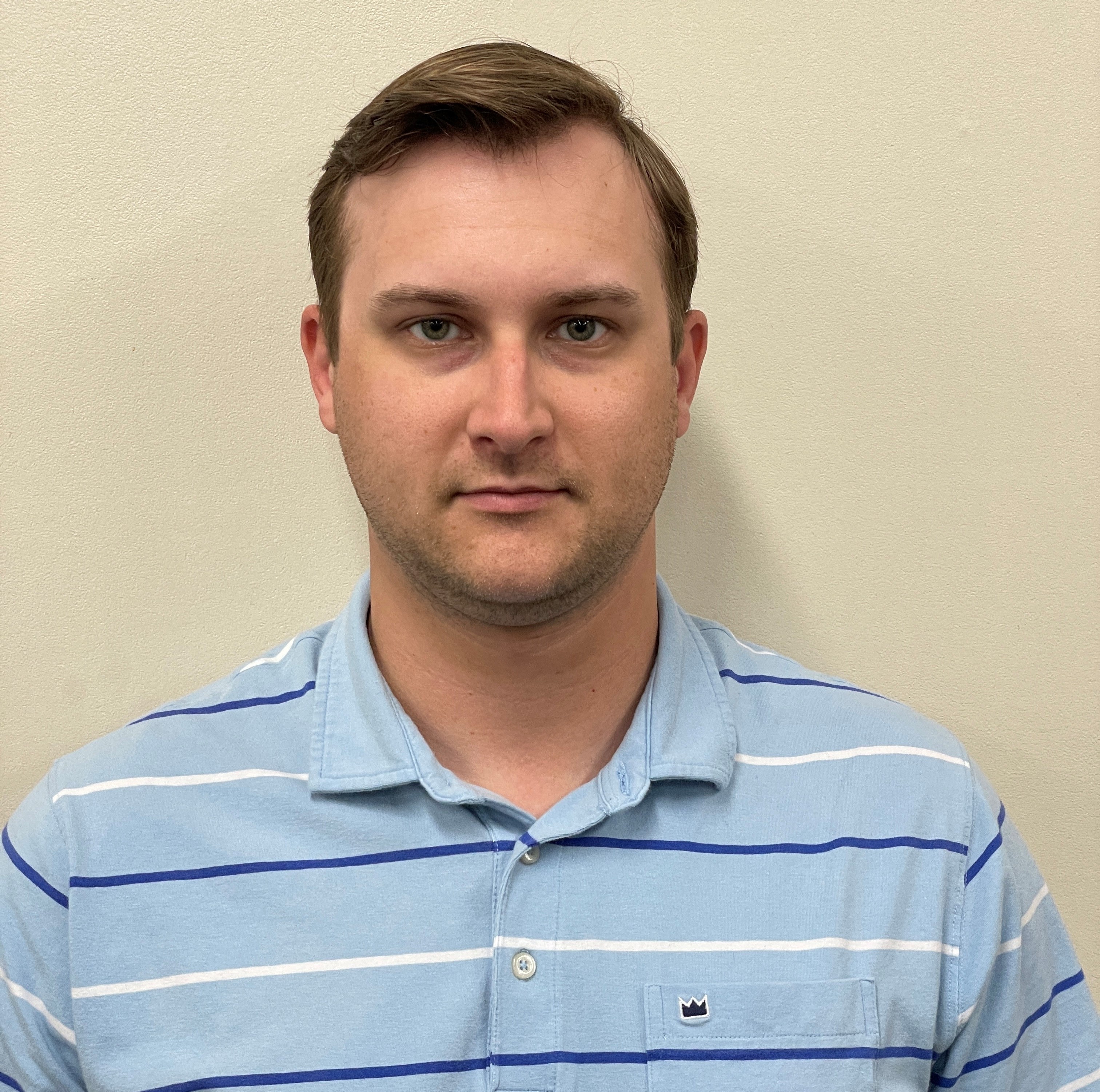
|
Systems Engineering | I am an Electronics Engineer with the US Air Force working at Eglin AFB, FL. I am a student in the Systems Engineering program currently, but I was a part of the first freshman class that FSU Panama City Hosted in the fall of 2013. | George Washington's Leadership through | George Washington was the leader America needed when fighting for independence. Throughout his life, however, he found himself seeking leadership roles and ways to better the people of the, at the time, colonies. This study focuses on the leadership qualities that Washington accrued through his life and how he applied them to not only his time as commander and chief of the revolutionary army, but also his time serving the British before the revolution and as our first president. George Washington is a unique leader in history because he did not come from nobility or have an extensive education to help support him. Lacking many of the traits required of the time, he persevered and became the greatest leader America had until that point, and one of the greatest examples that we have had since. | Dr. Daniel Georgiadis | College of Engineering | Industrial and Manufacturing Engineering Department | dgeorgiadis@fsu.edu | George Washington Leadership Leader | Complete | 2025 | 5th annual Undergraduate Research Symposium, April 17, 2025 | https://pc.fsu.edu/student-research/symposium/research-symposium-program-portal?element_parents=elements/student_photo&ajax_form=1&_wrapper_format=drupal_ajax&token=NVvPpiLxgXcwkRWjI1muxllEd2qifJQ827JZZX-NHos | |||||||
| 53 | 7781 | Face to Face Poster session | C - 6 R - 4 | Student Research Symposium Program Portal: Submission #53 | 702ec819-837f-48c6-84f5-17ef9411acc9 | No | Star/flag Student Research Symposium Program Portal: Submission #53 | Lock Student Research Symposium Program Portal: Submission #53 | Add notes to Student Research Symposium Program Portal: Submission #53 | Tue, 02/04/2025 - 02:24 PM | Tue, 02/04/2025 - 03:07 PM | Mon, 04/14/2025 - 01:46 PM | Anonymous | 150.176.163.200 | Saylor | Dezenzo | she/her | xdezesm@baystudent.org |

|
Undecided | I live in Panama City Beach attending J.R. Arnold High School as a junior. I enjoy painting, art, and science. One of my main interests growing up was the ocean and the environment in general. As of now, I really want to be a marine biologist specializing in coral ecology or an environmental engineer. I am in my second year of AICE Marine Science, and hope to continue in college. I plan on going to a 4 year University and majoring in environmental science to have a fulfilling career restoring the planet. | The Dissolution of Calcium Carbonate Shells | The overproduction of carbon dioxide in the atmosphere is absorbed by the ocean and increases acidity, which ends up dissolving calcium carbonate skeletons such as coral reefs and shells for crabs and other organisms. In this experiment with 3 trials, I would take 5 different shells of the same type, similar mass, and place them each in different cups of water with varying acidity. After a week, I would measure their mass again (after they dried to avoid water mass) and record the data in a table. | Danielle Brennan | Florida State University | Marine Biology | brenndc@bay.k12.fl.us | marine biology, ocean acidification, pH scale | Complete |
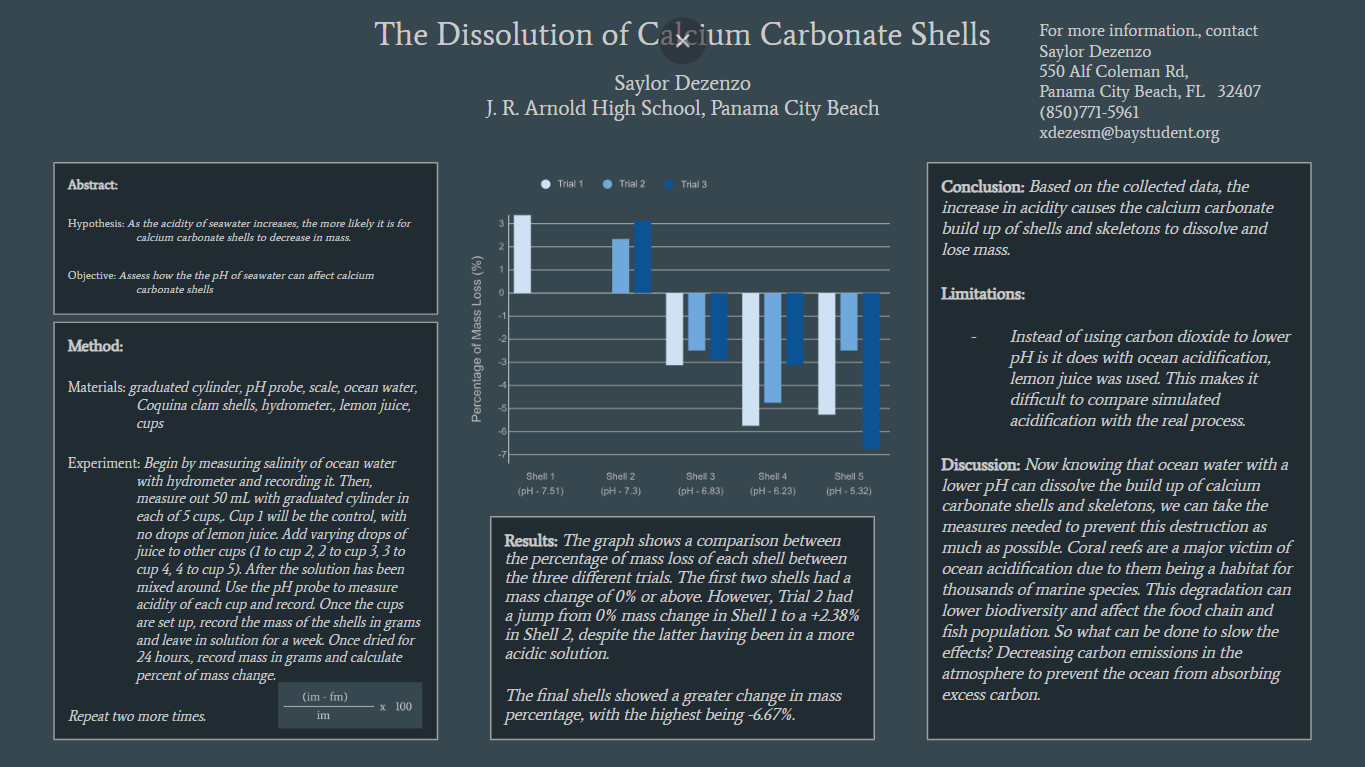
|
No | 2025 | 5th annual Undergraduate Research Symposium, April 17, 2025 | https://pc.fsu.edu/student-research/symposium/research-symposium-program-portal?element_parents=elements/student_photo&ajax_form=1&_wrapper_format=drupal_ajax&token=HV4pt9cIjd_LY4_wjO2kb-z-C4tt2sGvZ_uFCXb4EhU | ||||
| 52 | 7771 | Face to Face Poster session | C - 6 R - 1 | Student Research Symposium Program Portal: Submission #52 | ef23cd26-84b6-4d19-bbd6-82bb351f7c0b | No | Star/flag Student Research Symposium Program Portal: Submission #52 | Lock Student Research Symposium Program Portal: Submission #52 | Add notes to Student Research Symposium Program Portal: Submission #52 | Tue, 02/04/2025 - 11:22 AM | Tue, 02/04/2025 - 11:27 AM | Tue, 07/22/2025 - 09:51 AM | Anonymous | 150.176.163.200 | Macy | Maggiore | she/her | macy.maggiore@gmail.com |
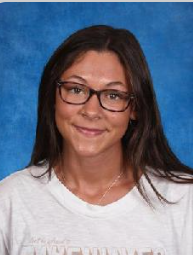
|
TBD | Hello my name is Macy Maggiore and I am a junior in high school. I have been swimming for 11 years and I have grown up with the sport. I became interested with the nutritional component of being an swimmer this year and I hope that through my case study I can help the swimmers around me. | Nutritional Timeline of Swimmers for Swim Meets | The study that I went through the process of investigating dove into how an athletes nutritional diet can impact their performance. Throughout my study I chose to utilize a case study research method in order to carry out the investigation and to reach my conclusion. My study uses a sample pool of four swimmers who practice year around. This sample pool includes two females and two males as well as an appropriate representation of types of swimmers throughout my study. The rest of my abstract I intend to carry out in the near future and well update in early March. Through my results I concluded that both types of male swimmers benefit in their times from consuming a high amount of carbohydrates before their race. On the other hand I found mixed results with the female results. The sprint swimmer significantly improved their times when they ate a lot of carbohydrates. Whereas, the distance female swimmer did better when eating less food. | Doedy Deal | Arnold High School | Health Sciences | dealdm@bay.k12.fl.us | none | none | Nutrition, Swimming, Performance | Complete | AHS_Template_2.pdf325.5 KB
|
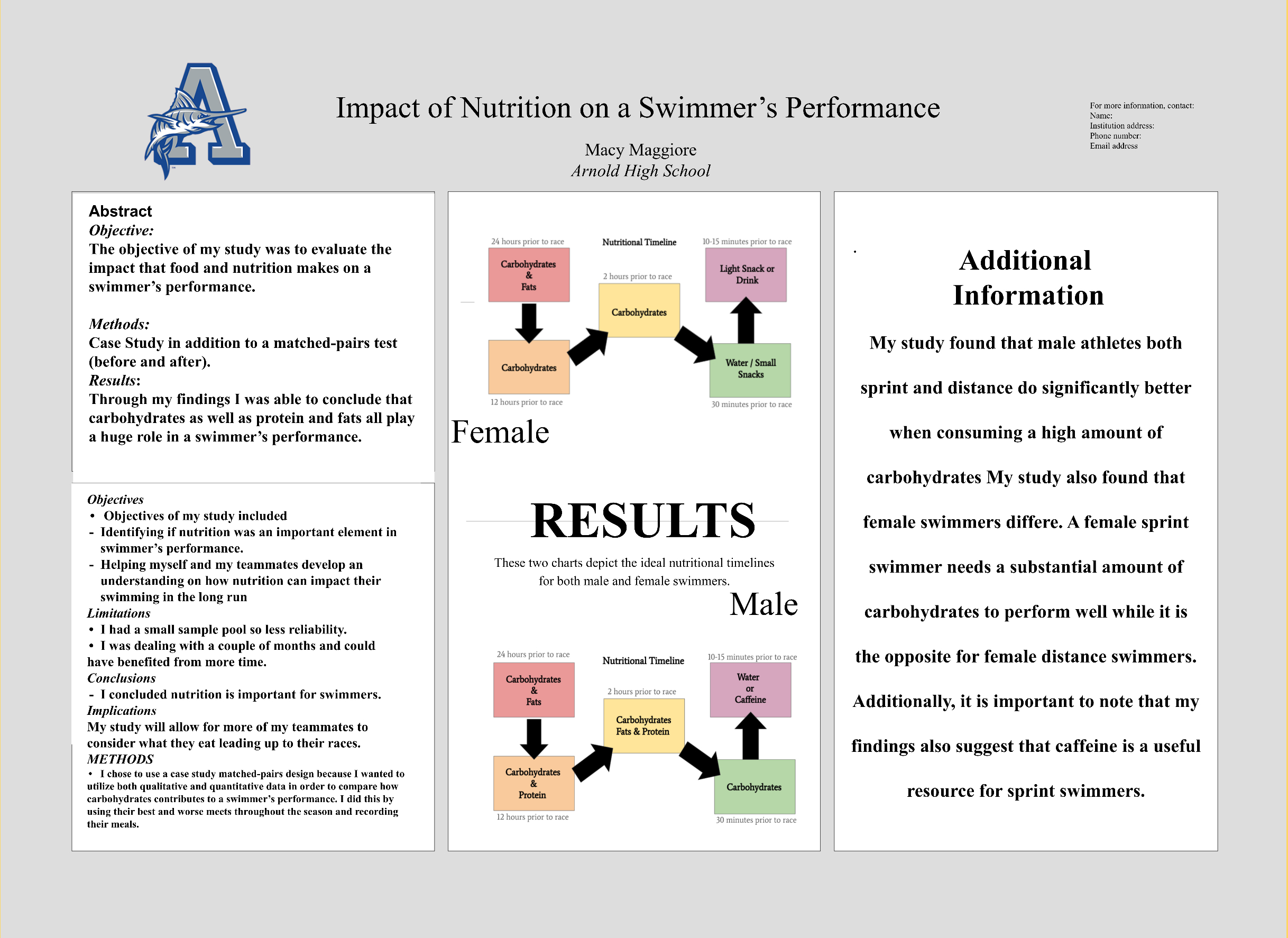
|
No | 2025 | 5th annual Undergraduate Research Symposium, April 17, 2025 | https://pc.fsu.edu/student-research/symposium/research-symposium-program-portal?element_parents=elements/student_photo&ajax_form=1&_wrapper_format=drupal_ajax&token=dwwKdL_8AQ95kKDpIJEGN8RUSgVreuAZEduvY4v38hg | |
| 51 | 7766 | Face to Face Poster session | C - 7 R - 5 | Student Research Symposium Program Portal: Submission #51 | e5d32e5b-6a61-4753-89fa-fe0d15a43449 | No | Star/flag Student Research Symposium Program Portal: Submission #51 | Lock Student Research Symposium Program Portal: Submission #51 | Add notes to Student Research Symposium Program Portal: Submission #51 | Tue, 02/04/2025 - 09:19 AM | Tue, 02/04/2025 - 11:25 AM | Mon, 04/14/2025 - 01:46 PM | Anonymous | 150.176.68.97 | Hassan | Tewfik | xtewfh@baystudent.org |
|
Political Science | I am a High School student currently enrolled at J.R. Arnold High School and I'm taking Dual Enrollment classes via Gulf Coast State College. I am interested in global humanitarian issues, especially the issues that occur in Palestine. I feel for Palestinians as I am Arab, and my cousins are Palestinians. I enjoy deep research on topics, such as Palestine, politics, government, etc. | The Impact of Human Rights Violations in Palestine on Palestinians in America | The Israeli-Palestinian conflict is a major foreign affair that has impacted millions around the world during the past 76 years. Within this time period, there have been a multitude of violations of human rights. Amnesty says that over the past 50 years, Israel has demolished more than 50,000 Palestinian homes. As human rights are being violated, I decided to research the question: To what extent does the disregard of human rights in Palestine affect Palestinians in the United States? In order to answer the question, I used a case study approach. Then I created a Google Form in which I asked a variety of questions. 20 individuals of Palestinian descent living in the United States answered a questionnaire inquiring about their point of view on human rights in Palestine. Numerous questions assessing their points of view regarding human rights in Palestine were asked. Both quantitative and qualitative responses were collected. To be edited… | Doedy Deal | Arnold High School | AP Research | dealdm@bay.k12.fl.us | Gaza, Palestine, Human Rights | Complete |
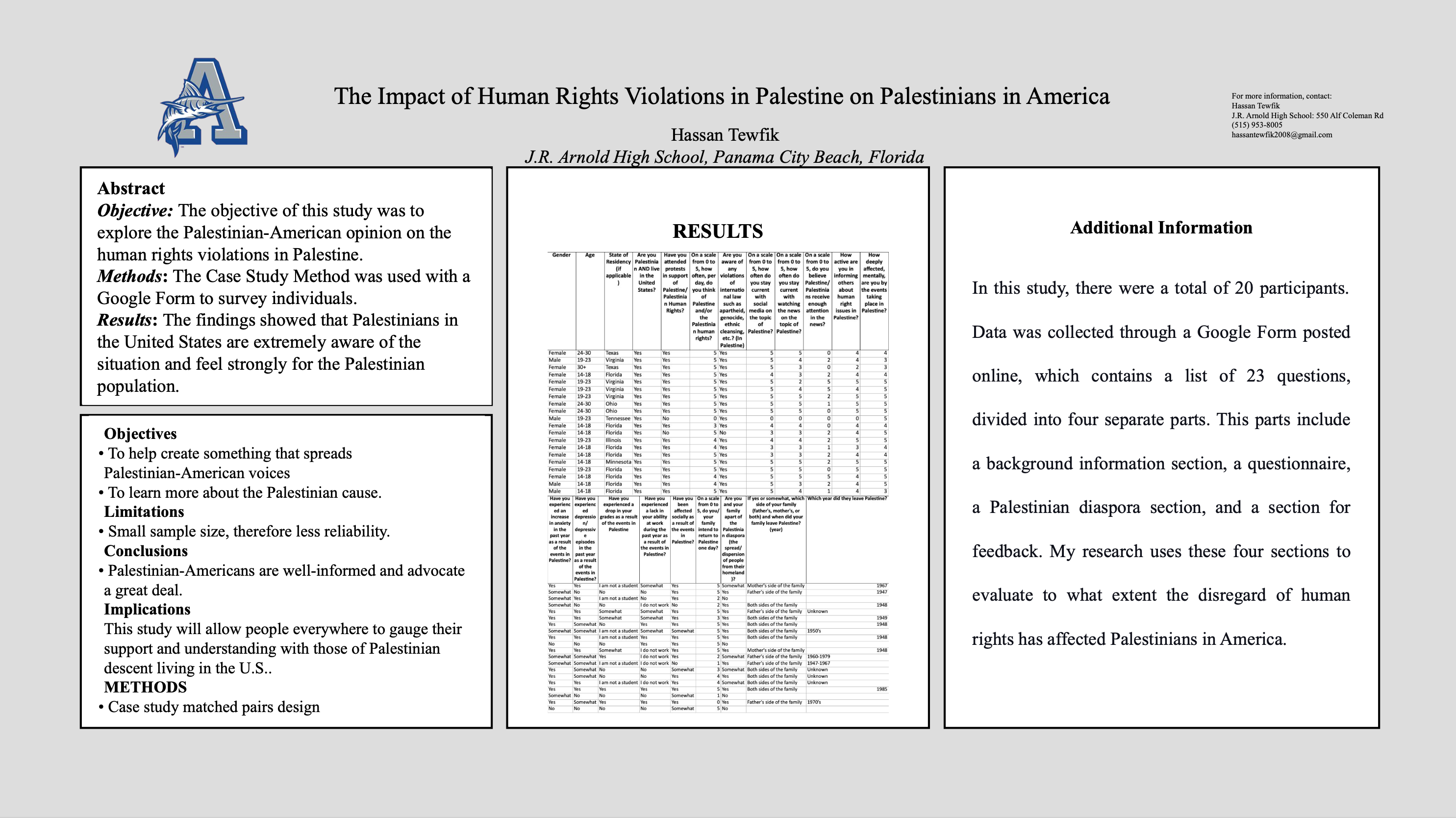
|
No | 2025 | 5th annual Undergraduate Research Symposium, April 17, 2025 | https://pc.fsu.edu/student-research/symposium/research-symposium-program-portal?element_parents=elements/student_photo&ajax_form=1&_wrapper_format=drupal_ajax&token=6n8rM-G9BbHxM6pmp5Rf7XQAeHC_MnuHP5b_lTxBS_g | |||||
| 50 | 7761 | Synchronous Online Presentation | https://pc.fsu.edu/student-research/symposium/symposium-program-2025/dnap | Student Research Symposium Program Portal: Submission #50 | 7cb98fea-0c7b-4ea7-8292-38f1a025cdf6 | No | Star/flag Student Research Symposium Program Portal: Submission #50 | Lock Student Research Symposium Program Portal: Submission #50 | Add notes to Student Research Symposium Program Portal: Submission #50 | Mon, 02/03/2025 - 07:28 PM | Mon, 02/03/2025 - 07:48 PM | Tue, 04/01/2025 - 08:47 AM | Anonymous | 172.59.67.20 | Cybill | Robinson | CR22O@fsu.edu |
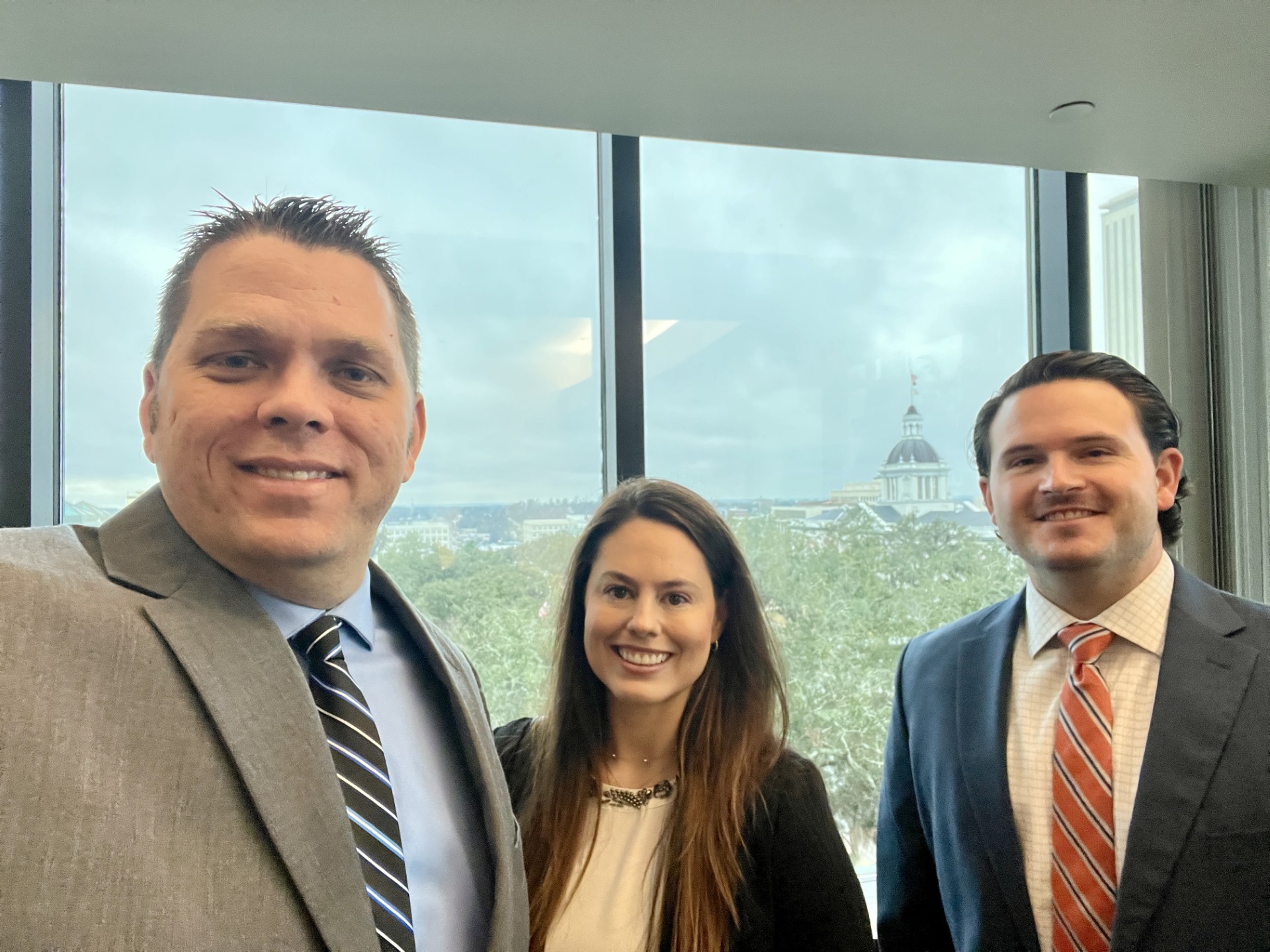
|
Doctor of Nurse Anesthesia Practice - DNAP | This group, in accordance with graduation requirements, is presenting a quality improvement project on the use of dexmedetomidine in neurosurgical spine cases. We have a deep passion for anesthesia and its evolving role in patient care. Our interest in dexmedetomidine stems from its ability to provide sedation while preserving respiratory function and offering neuroprotective benefits, making it a valuable tool in anesthesia management. With a strong commitment to advancing our knowledge and clinical skills, we aspire to contribute to the field of anesthesia by optimizing patient outcomes, particularly in complex surgical cases, through evidence-based practices and innovative approaches. | Dexmedetomidine in neurosurgical spine procedures | Due to its unique pharmacological properties, dexmedetomidine, a selective α2-adrenergic agonist, has gained significant attention in clinical practice. This literature review explores its role in neurosurgical spine surgeries, guided by the PICO question: Do adult patients undergoing neuroskeletal spine procedures (P) who receive perioperative dexmedetomidine (I), compared to those who do not (C), require less perioperative narcotics (O)? A total of six research articles were critically reviewed from CINAHL, PubMed, and Cochrane, including four systematic reviews and meta-analyses totaling 53 studies with 3,379 patients, and two randomized control trials with 172 patients. Four of the six studies provided strong statistical evidence (95% confidence intervals) that dexmedetomidine reduces PACU opioid consumption and postoperative pain intensity. Dexmedetomidine offers advantages such as stable hemodynamics, minimal respiratory depression, and reduced opioid requirements. Additionally, it has neuroprotective properties, reduces emergence delirium, and decreases shivering and postoperative nausea and vomiting. It facilitates smoother extubation and enhances postoperative outcomes. However, potential complications, including bradycardia and hypotension, require cautious administration. This quality improvement project aimed to present these findings to staff and encourage dexmedetomidine use in neurosurgical procedures. Despite successful collaboration with anesthesia staff, unforeseen bureaucratic hurdles delayed access to medication records, preventing the collection of required pre- and post-data. Nonetheless, this project highlights dexmedetomidine’s potential as a valuable adjunct in neurosurgical spine surgeries and the need for continued research and institutional support to optimize its use in clinical practice. | Lonnie Hodges, DNP, CRNA, CHSE, LtCol USAF(ret) | Florida State University | Nurse Anesthesia Program | lwhodges@pc.fsu.edu | Jerry Hogan | Jeremy Matyjaszek and Matthew Usry | Dexmedetomidine, neurosurgical spine procedures, Precedex | Complete | PDF Anesthesia Poster.pdf856.11 KB
|
No | 2025 | 5th annual Undergraduate Research Symposium, April 17, 2025 | https://pc.fsu.edu/student-research/symposium/research-symposium-program-portal?element_parents=elements/student_photo&ajax_form=1&_wrapper_format=drupal_ajax&token=sy8LDhLQOZFxEDYP405dyHXrMlX4kF55qPJ9KoOvZy8 | |||
| 49 | 7756 | Synchronous Online Presentation | https://pc.fsu.edu/student-research/symposium/symposium-program-2025/dnap | Student Research Symposium Program Portal: Submission #49 | 42fa8b5c-34d1-4778-8bb0-f628a4107eee | No | Star/flag Student Research Symposium Program Portal: Submission #49 | Lock Student Research Symposium Program Portal: Submission #49 | Add notes to Student Research Symposium Program Portal: Submission #49 | Mon, 02/03/2025 - 06:38 PM | Mon, 02/03/2025 - 06:45 PM | Tue, 04/01/2025 - 08:55 AM | Anonymous | 73.171.230.247 | Andre | Zumerchik | ajz22b@fsu.edu |
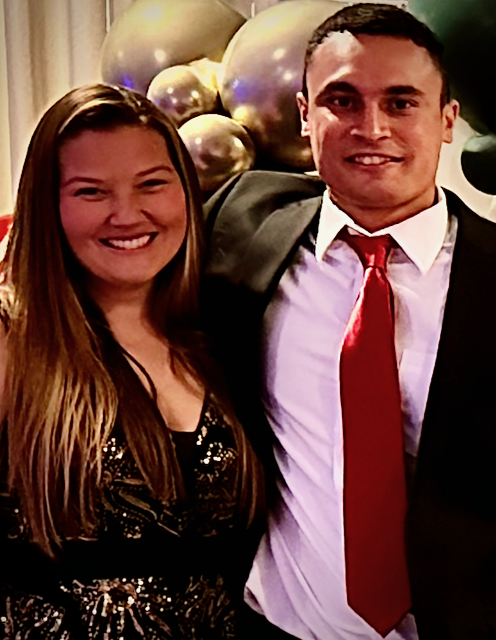
|
Nurse Anesthesia Practice-DNAP | Names: Tami Williams & Andre Zumerchik Major: Nurse Anesthesia Practice-DNAP Academic Background: Tami obtained her BSN from the University of North Florida and practiced as a nurse for 11 years, working across the country, prior to joining the Florida State Family at Panama City. Andre completed his undergraduate degree at Quinnipiac University in 2019. Practiced as a nurse for 3 years in Hartford, Connecticut and Chicago Illinois before coming to Florida State University here at Panama City. |
Do adult patients (P) undergoing surgery that receive a prophylactic eye lubricant (I) compared to those who do not (C) experience less corneal abrasions (O) | Abstract When a patient undergoes a surgical procedure requiring general anesthesia, they lose the ability to close the eyelids and protect their corneas. The corneal reflex for tear secretion is diminished during general anesthesia (Grixti et al., 2013). Constant rubbing of a dry and exposed cornea contributes to the development of corneal abrasions, which account for 35% of all ocular injuries, making them the most common type reported during the perioperative period (Moos & Lind, 2006). These abrasions are remarkably painful. Aside from the significant pain and inconvenience for the patient, there is an increase in health care cost, length of stay and resource use. The following PICO question was used to conduct a literature search: Do adult patients (P) undergoing surgery that receive a prophylactic eye lubricant (I) compared to those who do not (C) experience less corneal abrasions (O)? The literature search yielded two systematic reviews and two randomized control trials. The evidence from these studies demonstrated that measures such as manual eye closure and prophylactic eye lubrication can prevent corneal abrasions. This project aimed to increase the use of carboxymethylcellulose, a water-based lubricant, in an anesthesia practice in Northeast Florida. A series of targeted interventions were implemented to encourage lubricant usage, including provider education, educational posters, and laminated reminders in the operating and procedure areas. After data collection, eye lubrication nearly doubled to 12.7% from 6.8% the previous month. There was an increased adoption of carboxymethylcellulose eye lubricant as a preventive measure against corneal abrasions. |
Stacey VanDyke | Florida State University | Nurse Anesthesia | svandyke@fsu.edu | Gerard Hogan | Corneal Abrasion, Carboxymethylcellulose, eye lubrication | Complete | PosterForSymposium(2.2025).pdf269.5 KB
|
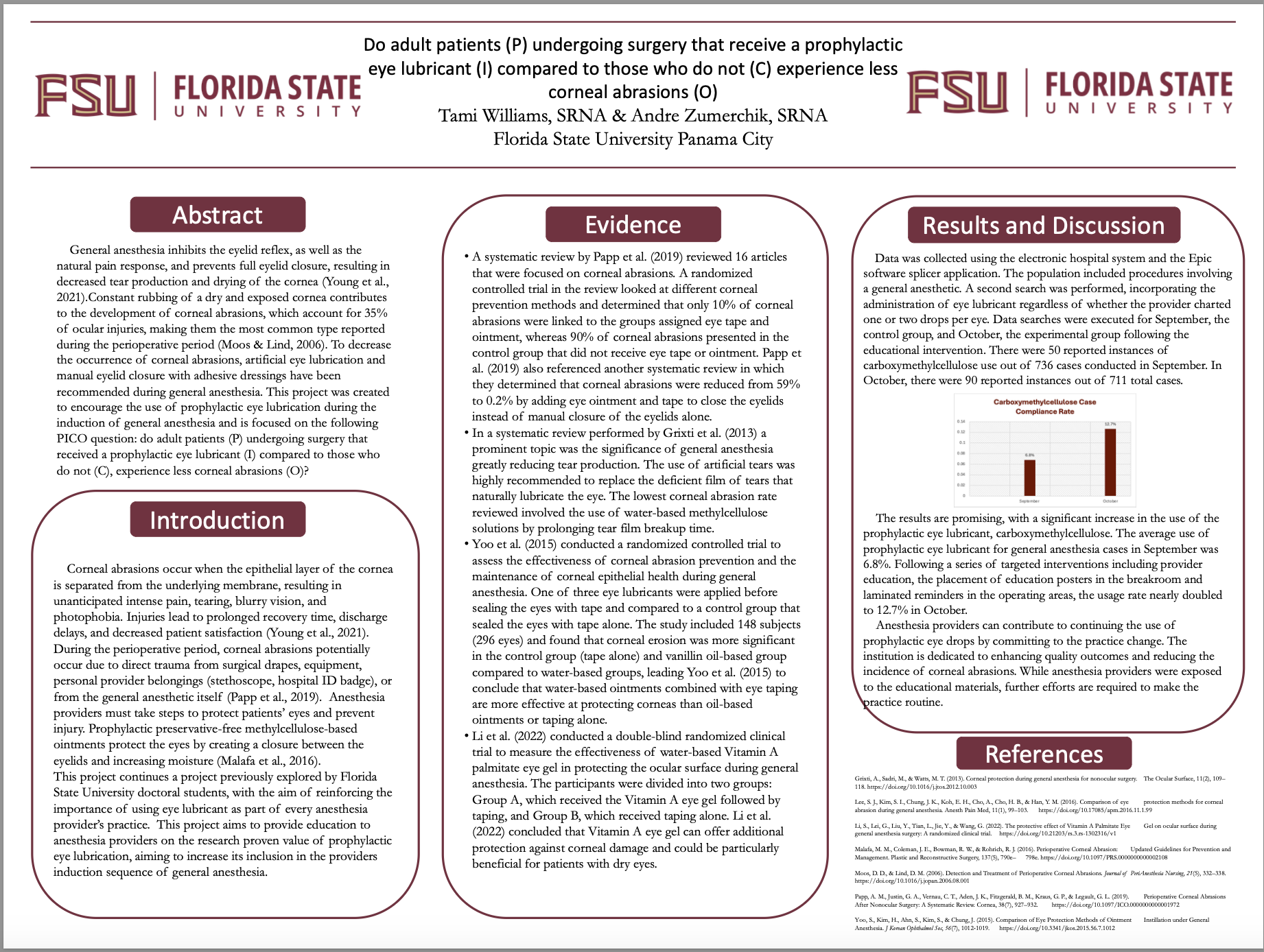
|
No | 2025 | 5th annual Undergraduate Research Symposium, April 17, 2025 | https://pc.fsu.edu/student-research/symposium/research-symposium-program-portal?element_parents=elements/student_photo&ajax_form=1&_wrapper_format=drupal_ajax&token=LjQJnTF0fSNGEfOv1tGcM2a1aCAdR7Zoh6XAPGuLDQM | |||
| 48 | 7746 | Synchronous Online Presentation | https://pc.fsu.edu/student-research/symposium/symposium-program-2025/dnap | Student Research Symposium Program Portal: Submission #48 | 77ad57a2-f9c0-441e-acfe-febb6bbf3f7d | No | Star/flag Student Research Symposium Program Portal: Submission #48 | Lock Student Research Symposium Program Portal: Submission #48 | Add notes to Student Research Symposium Program Portal: Submission #48 | Mon, 02/03/2025 - 03:39 PM | Mon, 02/03/2025 - 03:51 PM | Tue, 04/01/2025 - 08:49 AM | Anonymous | 76.26.24.184 | Daniel | O'Malley | do22c@fsu.edu |
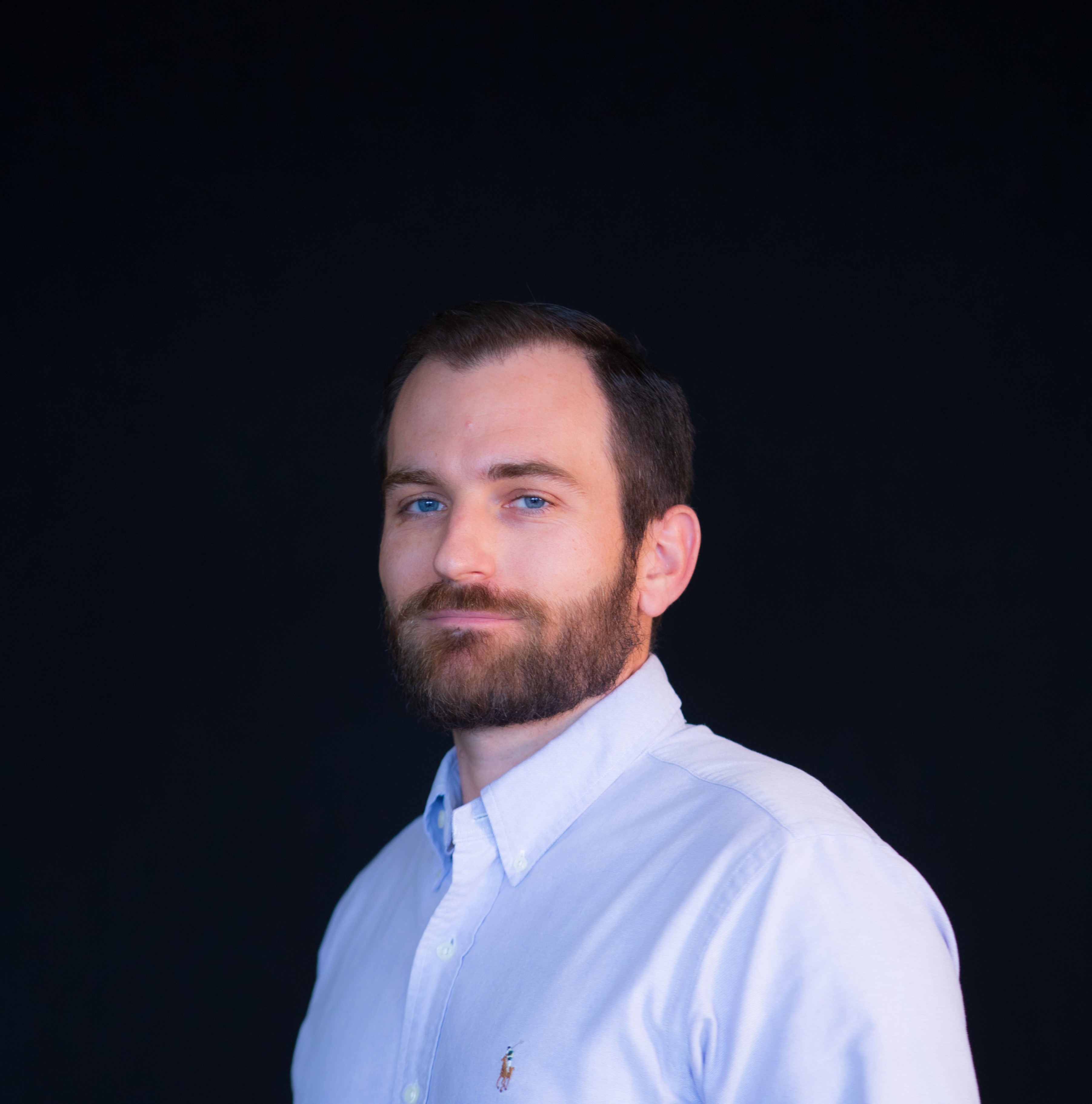
|
Nurse Anesthesia | Dan O'Malley and Becca Lisson are both students in the 2025 Doctor of Nurse Anesthesia Practice program. Both students completed their clinical training in South Florida where they became interested in the optimal lidocaine dosing strategy for EGD procedures after seeing variations in practice between clinical sites and among different practitioners. | Weight-Based Lidocaine Dosing Decreases Propofol Dose Required for Esophagogastroduodenoscopy Procedures | Propofol is the most used agent to provide anesthesia for esophagoduodenoscopy (EGD) procedures. Side effects of propofol include pain on injection, hypotension, and apnea/upper airway obstruction (Hu et al., 2022). A small dose of lidocaine is commonly administered to prevent pain on propofol injection. However, lidocaine has sedative and analgesic properties of its own, and administering a 1.5 mg/kg dose of lidocaine reduces the induction dose and total dose of propofol required for EGDs. The following PICO question was used: (P) Do adult patients undergoing propofol-based sedation EGD procedures, (I) that receive a 1.5mg/kg lidocaine bolus, (C) compared to those that receive less than 1.5mg/kg of lidocaine, (O) require less propofol? |
Gerard Hogan | College of Applied Sciences | Nurse Anesthesia | ghogan@pc.fsu.edu | Rebecca Lisson | Lidocaine anesthesia esophagogastroduodenoscopy | Complete |
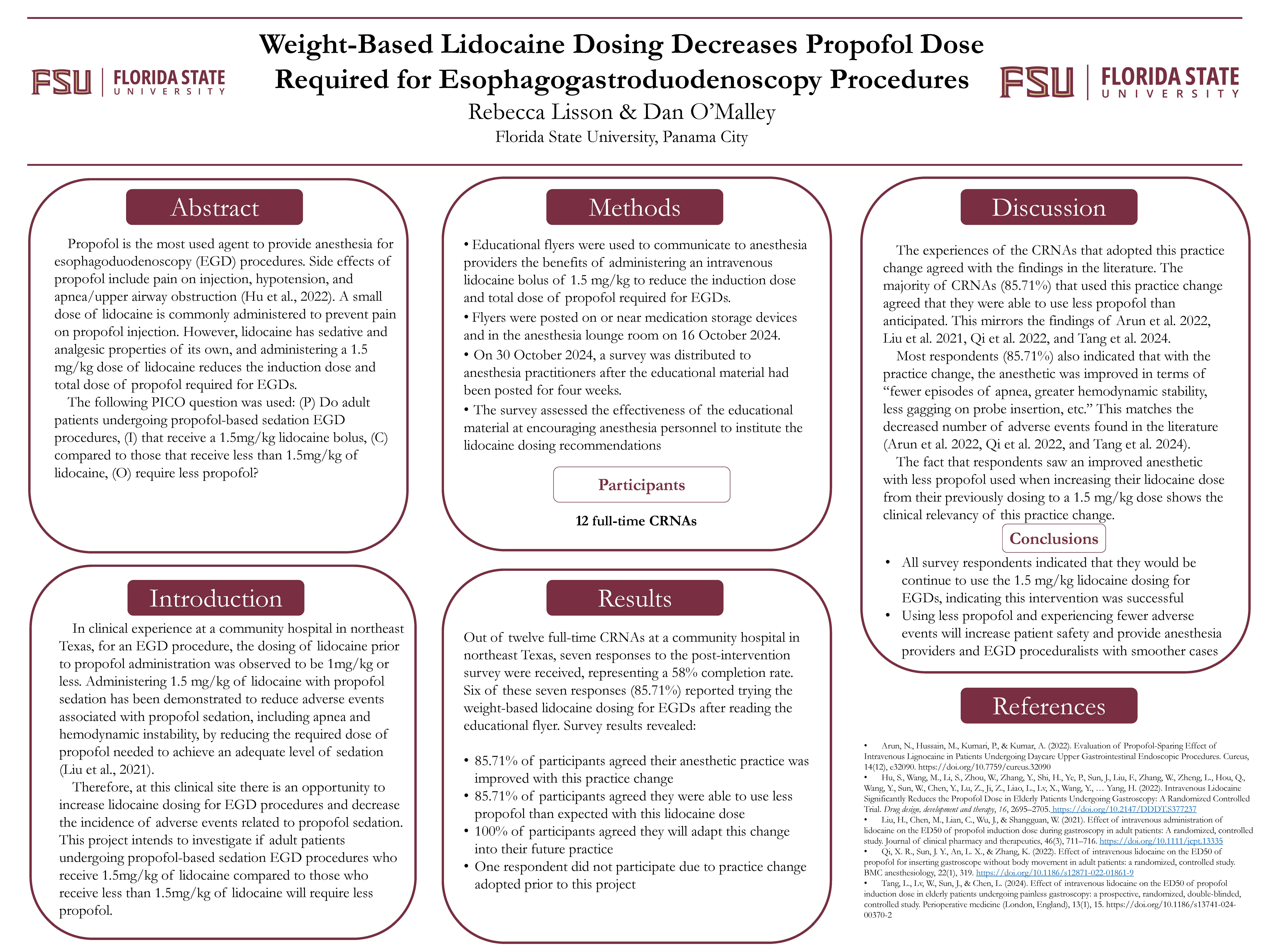
|
No | 2025 | 5th annual Undergraduate Research Symposium, April 17, 2025 | https://pc.fsu.edu/student-research/symposium/research-symposium-program-portal?element_parents=elements/student_photo&ajax_form=1&_wrapper_format=drupal_ajax&token=FFiz0mVgPWj9afyQBiwnpyK4XceYwM3zZ7LAH1JjsWY | ||||
| 47 | 7741 | Synchronous Online Presentation | https://pc.fsu.edu/student-research/symposium/symposium-program-2025/dnap | Student Research Symposium Program Portal: Submission #47 | 935c286b-b2ed-4249-8e0b-2db6adb06e63 | No | Star/flag Student Research Symposium Program Portal: Submission #47 | Lock Student Research Symposium Program Portal: Submission #47 | Add notes to Student Research Symposium Program Portal: Submission #47 | Mon, 02/03/2025 - 02:24 PM | Mon, 02/03/2025 - 02:25 PM | Fri, 05/02/2025 - 12:10 PM | Anonymous | 72.216.12.2 | Ryan | Bracey | reb22c@fsu.edu |
|
Bachelors of Science in Nursing, Doctorate of Nurse Anesthesia Practice (in progress) | This group is presenting, for graduation requirement, an anesthesia based quality improvement project concerning ketamine usage in patients undergoing laparoscopic cholecystectomies. | Ketamine for Intraoperative Analgesia in Laparoscopic Cholecystectomies | This quality improvement project aimed to evaluate certified registered nurse anesthetists' (CRNAs) perspectives on ketamine use during laparoscopic cholecystectomies and examine the influence of evidence-based education on their clinical practice. A survey was distributed to CRNAs in one specific hospital location as the project's primary focus. The initial questionnaire explored current ketamine usage, concerns with its application, routine use of antiemetics to mitigate postoperative nausea and vomiting (PONV), confidence in ketamine's ability to reduce postoperative pain compared to other nonopioid analgesics, and whether evidence of ketamine's efficacy in reducing opioid use and enhancing pain control would influence their practice. Respondents were then presented with a synthesis of evidence highlighting ketamine's effectiveness as an alternative analgesic in this context. A follow-up survey assessed changes in their likelihood to incorporate ketamine into their practice. Findings from this project provide insights into CRNAs' perceptions of ketamine and the potential of evidence-based interventions to influence anesthesia practices aimed at improving postoperative outcomes. The survey results indicate that CRNAs recognize the potential benefits of ketamine as part of a multimodal analgesic plan but are also mindful of its unwanted side effects and practical challenges at their current workplace. However, after reviewing the provided evidence synthesis, most respondents expressed a greater willingness to integrate ketamine into their practice despite their previous utilization of ketamine. | Jason Smith | Florida State Univeristy | Nurse Anesthesia | jcsmith3@fsu.edu | Gerard Hogan | Ashley Hagan, Janneza King | Ketamine, Anesthesia, Pain | Complete |
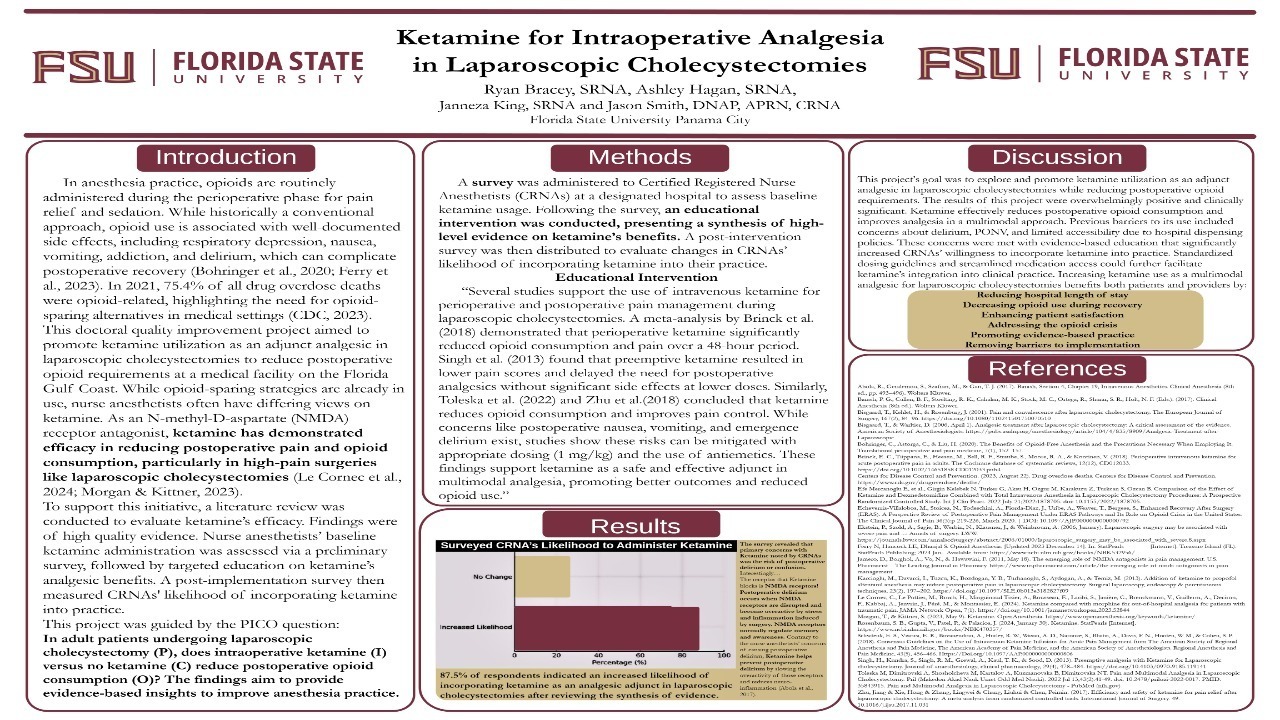
|
No | 2025 | 5th annual Undergraduate Research Symposium, April 17, 2025 | https://pc.fsu.edu/student-research/symposium/research-symposium-program-portal?element_parents=elements/student_photo&ajax_form=1&_wrapper_format=drupal_ajax&token=9fNOC9LnvCFm98T6LuiMGmCaOaEBynuj7oEf4lwabWA | |||
| 46 | 7736 | Synchronous Online Presentation | https://pc.fsu.edu/student-research/symposium/symposium-program-2025/dnap | Student Research Symposium Program Portal: Submission #46 | c49aa13f-c8b1-4232-9f32-fd2a1de173fd | No | Star/flag Student Research Symposium Program Portal: Submission #46 | Lock Student Research Symposium Program Portal: Submission #46 | Add notes to Student Research Symposium Program Portal: Submission #46 | Mon, 02/03/2025 - 12:18 PM | Mon, 02/03/2025 - 12:45 PM | Tue, 04/01/2025 - 08:37 AM | Anonymous | 68.205.199.196 | Richard | Lang | rl22l@fsu.edu |
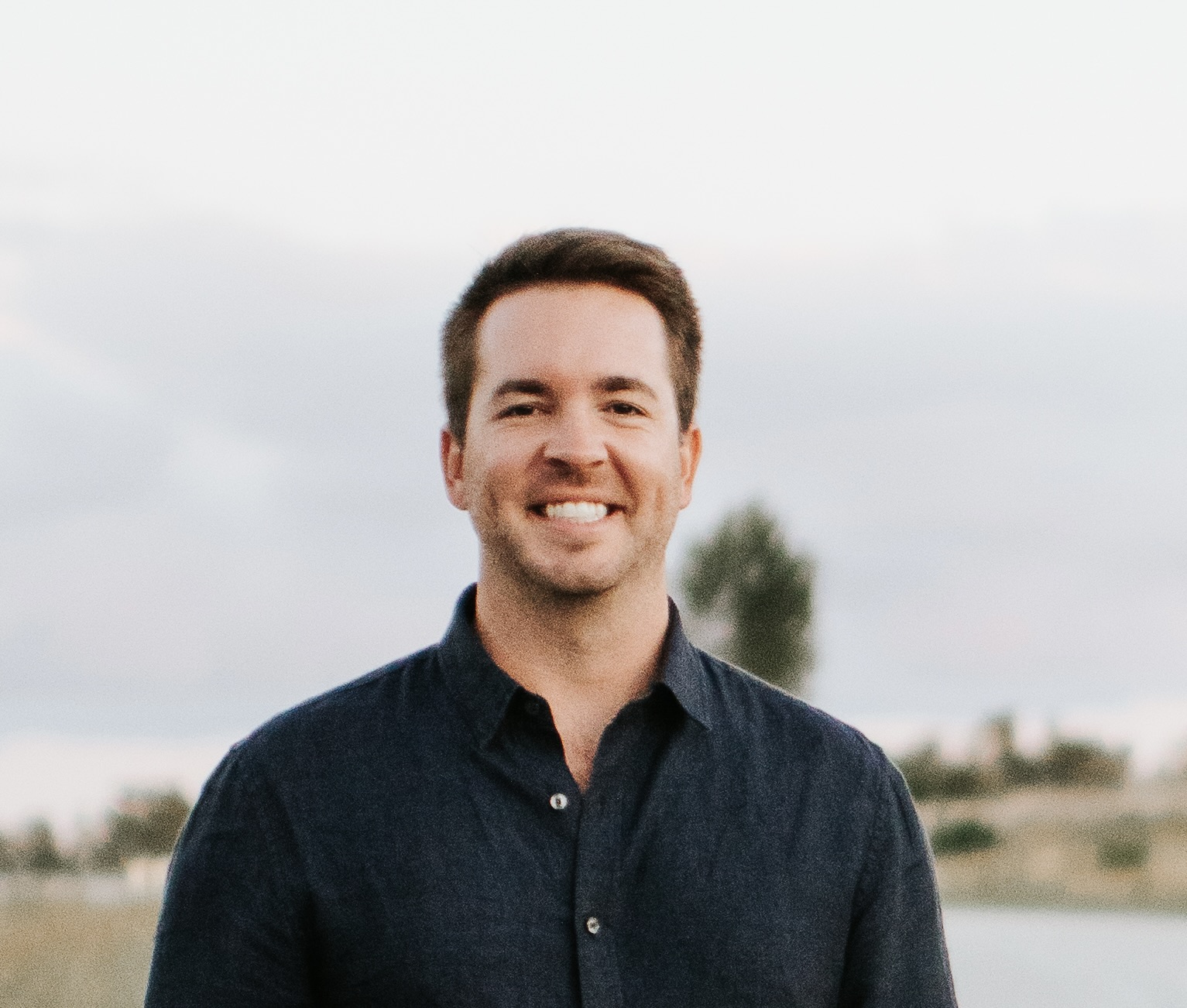
|
Doctor of Nurse Anesthesia Practice | Richard Lang is a Florida State University Doctor of Nurse Anesthesia Practice senior student. Richard spends his free time with his wife, Paige, and son, Preston. Richard and Preston have fun on the golf course near their home in Orlando, FL. After graduation he will be joining the anesthesia team at AdventHealth Orlando. | Midazolam Mask Ventilation | Mask ventilation is one of the most critical steps in a safe anesthetic induction. However, many clinicians can struggle to maintain adequate mask ventilation. Studies have shown that administering midazolam before entering the operating room improves mask ventilation and improves placement of adjunct airways. This project was set in a hospital in central Florida. Flyers were attached to pyxis machines in each operating room, informing the certified registered nurse anesthetists (CRNA) of difficult mask ventilation characteristics, the benefits of midazolam administration prior to induction of anesthesia, and the studies showing improvement in ventilation following midazolam administration. Data regarding the current pre-operative administration of midazolam, whether the CRNA has had trouble with mask ventilation, and whether the CRNA will increase their use of pre-operative administration, especially in patients with difficult mask ventilation characteristics via an anonymous survey was collected. This paper discusses the difficulty of mask ventilation and asks the question: do patients who receive midazolam for sedation and anxiolysis preoperatively, compared to those patients who do not, have less difficult mask ventilation issues? | Dr. Gerard Hogan | Florida State University | Nurse Anesthesia | ghogan@fsu.edu | Adrienne Belcher | Midazolam Mask Ventilation | Complete | Poster ppt final.pdf253.35 KB
|
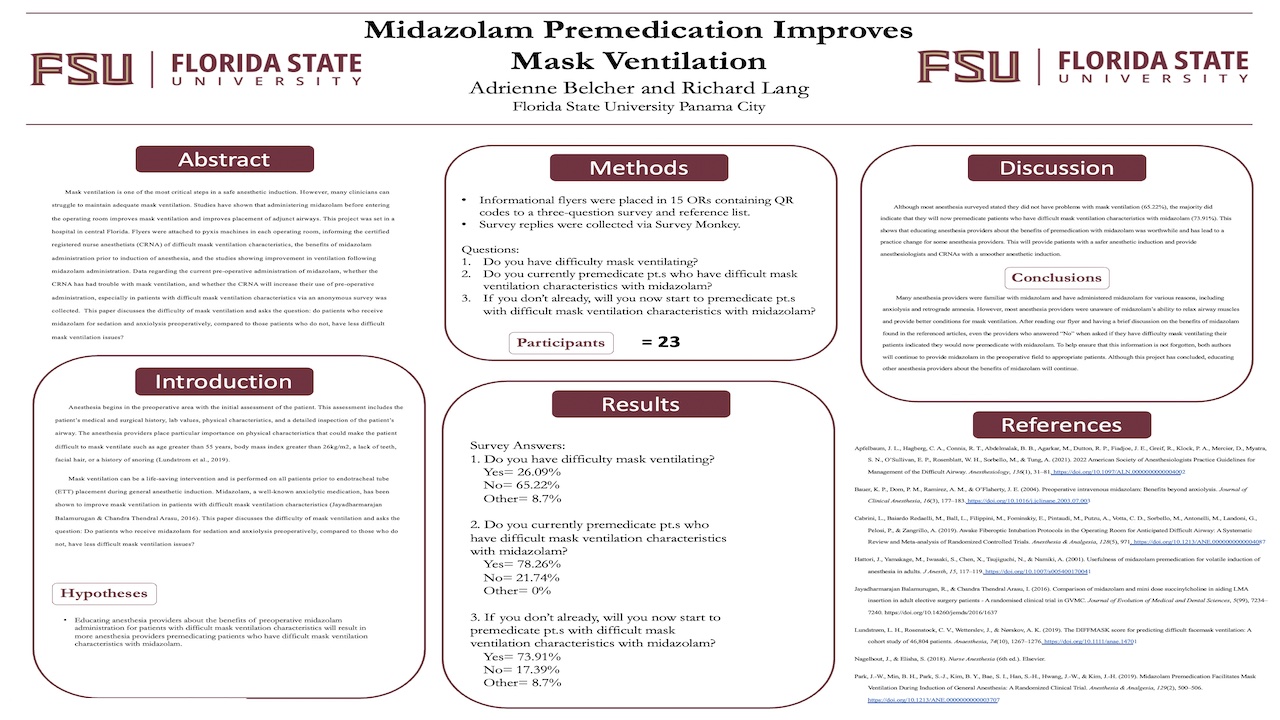
|
No | 2025 | 5th annual Undergraduate Research Symposium, April 17, 2025 | https://pc.fsu.edu/student-research/symposium/research-symposium-program-portal?element_parents=elements/poster_pdf&ajax_form=1&_wrapper_format=drupal_ajax&token=33GaevLcLY6BnqzxML0B7Luj0bGejdiPjRSJxZ_mak8 | |||
| 45 | 7731 | Face to Face Poster session | C - 6 R - 3 | Student Research Symposium Program Portal: Submission #45 | 788f3f35-a48f-4f0e-8b26-b3bfc7411e59 | No | Star/flag Student Research Symposium Program Portal: Submission #45 | Lock Student Research Symposium Program Portal: Submission #45 | Add notes to Student Research Symposium Program Portal: Submission #45 | Mon, 02/03/2025 - 11:46 AM | Mon, 02/03/2025 - 11:46 AM | Mon, 04/14/2025 - 01:44 PM | Anonymous | 150.176.163.200 | Dylan | Zeigler | He/him | xZeigDE@baystudent.org |
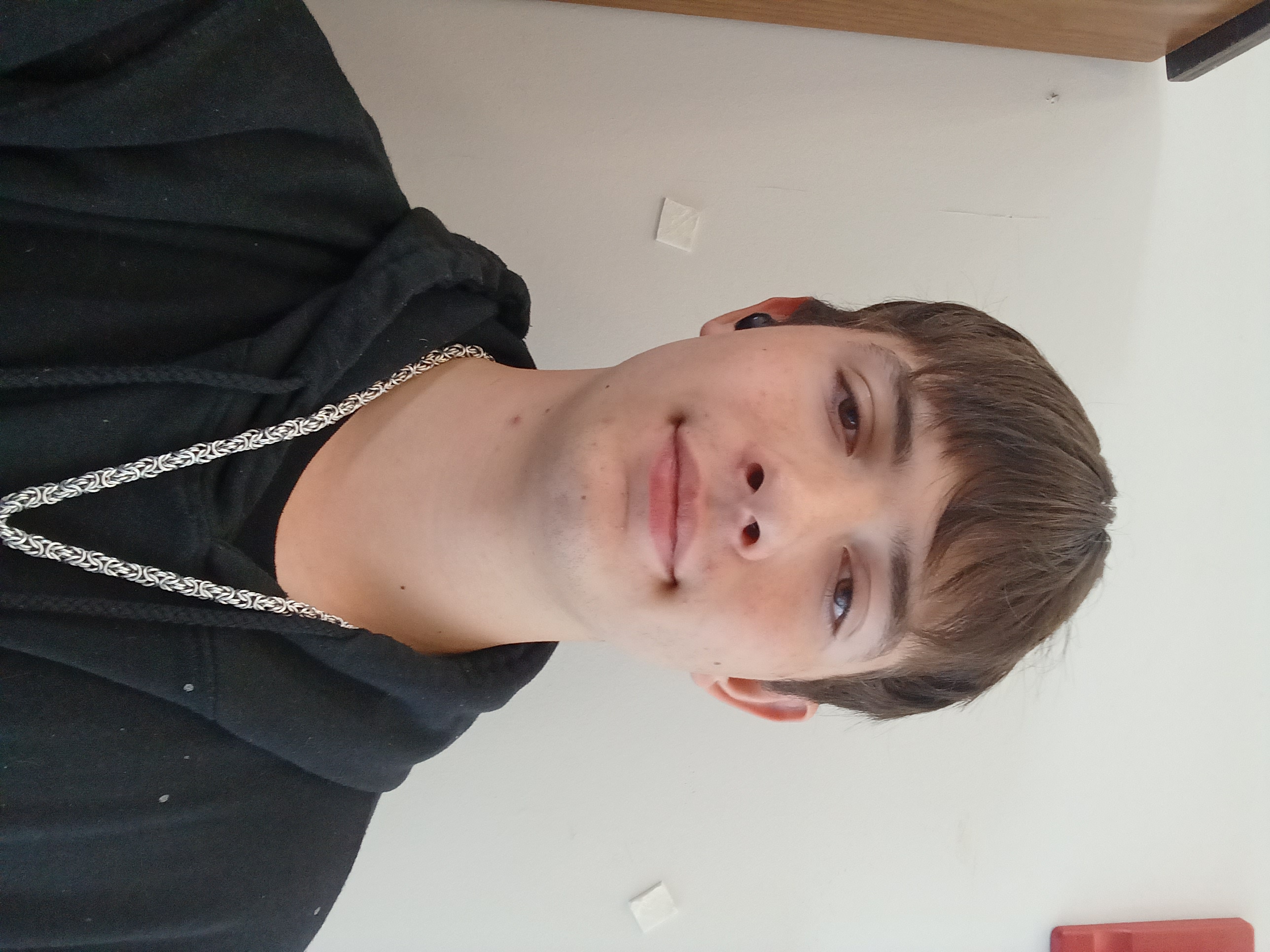
|
Theology | My name is Dylan Zeigler I have been interested in theology for awhile now and as a hobby I have been investigating homiletical plot. I have grown up in the church and have been studying theology for most of my life. | Homiletics and the First Great Awakening | Looking at the Sermons of brilliant clergymen of the First Great Awakening I found that they all used an expository format but the ratio of Law and Gospel differed depending on the Sermons goal. Such as Jonathan Edwards sermon "Sinners in the Hands of an Angry God" is focused on condemning his congregations complacency in their sin, but other Sermons focused on the salvation provided by Jesus's death on the cross. However the importance of their Sermons to the spread of Awakening ideals is expansive as the development of Edwards ideas of correcting the complacency of his congregation spread throughout the American colonies and through George Whitfield spread to Europe. | Sherri Dotson | J.R. Arnold High School | AP English Components | dotsoss@bay.k12.fl.us | none | Homiletics, Sermons, History, Awakening | Complete | research presentation.pdf149.38 KB
|
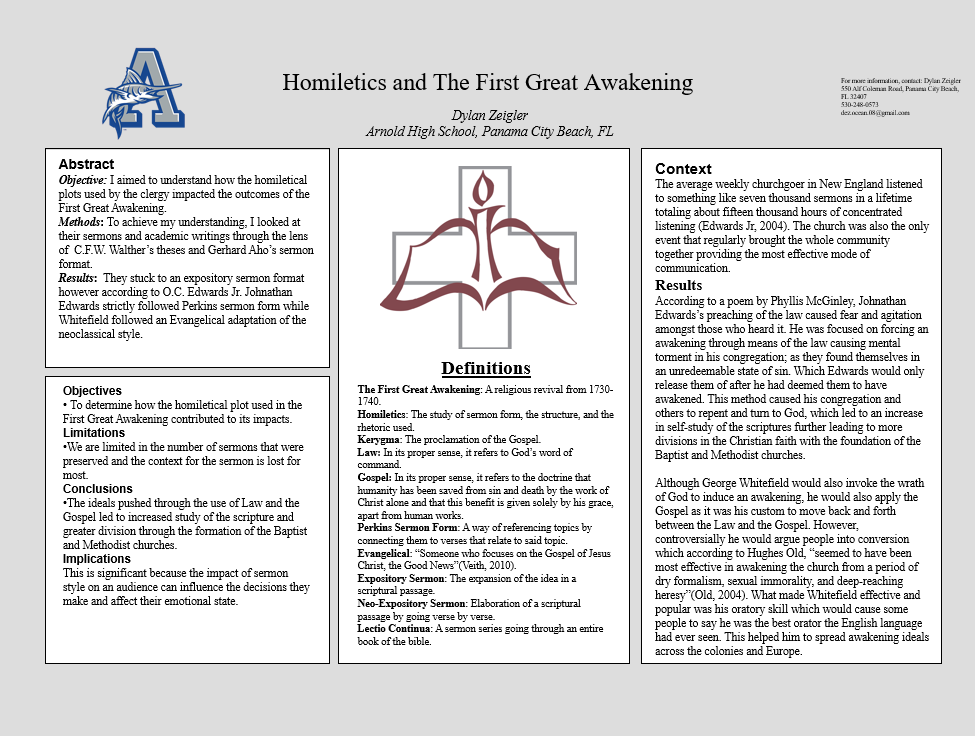
|
No | 2025 | 5th annual Undergraduate Research Symposium, April 17, 2025 | https://pc.fsu.edu/student-research/symposium/research-symposium-program-portal?element_parents=elements/student_photo&ajax_form=1&_wrapper_format=drupal_ajax&token=vVZ9zF_5UYbgQFl_WmD48VsH5Zf2gN4F9uHWMclmooE | ||
| 44 | 7721 | Asynchronous Online Presentation | https://pc.fsu.edu/student-research/symposium/symposium-program-2025/systems-engineering | Student Research Symposium Program Portal: Submission #44 | e6152169-8253-4dff-923c-9b18df00d894 | No | Star/flag Student Research Symposium Program Portal: Submission #44 | Lock Student Research Symposium Program Portal: Submission #44 | Add notes to Student Research Symposium Program Portal: Submission #44 | Sun, 02/02/2025 - 08:17 PM | Sun, 02/02/2025 - 08:29 PM | Tue, 04/01/2025 - 07:25 AM | Anonymous | 165.166.43.59 | Fernando | Carrillo | fc20a@fsu.edu |
|
Biomedical Engineering | I have been at Florida State University for nearly five years now. From my bachelor's degree in biomedical engineering to my master's degree in the same field, I have loved the entire experience. In my senior year of my undergraduate studies, I took part in the Honors in the Major program, studying a possible treatment for ischemia. Now, in my last semester of my master's program, I have decided to branch out and focus on the various ways I could improve my leadership skills. | Jimmy Carter: A Leader Lead by Compassion | Former president Jimmy Carter was a person known for his compassion and idealistic approach to solving problems around the globe. From advocating for racial equality during his tenure in The Oval Office to working with Habitat for Humanity in the years that followed, Jimmy Carter prioritized the wellbeing of those he worked with. This research aims to delve into the endeavors of Jimmy Carter in a way that highlights his leadership style and defines the traits that allowed him to be such an influential figure. The goal is to study and explain the various ways he achieved all that he did through the lens of various leadership concepts and theories in order to explain what set him apart from others in similar positions. | Dr. Daniel R. Georgiadis | Florida State University | Systems Engineering Leadership | dgeorgiadis@eng.famu.fsu.edu | Leadership, History, Politics, Presidents | Complete | 2025 | 5th annual Undergraduate Research Symposium, April 17, 2025 | https://pc.fsu.edu/student-research/symposium/research-symposium-program-portal?element_parents=elements/student_photo&ajax_form=1&_wrapper_format=drupal_ajax&token=f_FvweMfmZafm1XEYLPV9GodD7jab0vou2ITJUxGPWI | |||||||
| 43 | 7716 | Asynchronous Online Presentation | https://pc.fsu.edu/student-research/symposium/symposium-program-2025/systems-engineering | Student Research Symposium Program Portal: Submission #43 | 29f45477-608e-46e5-82d8-117e72b27b35 | No | Star/flag Student Research Symposium Program Portal: Submission #43 | Lock Student Research Symposium Program Portal: Submission #43 | Add notes to Student Research Symposium Program Portal: Submission #43 | Sun, 02/02/2025 - 05:13 PM | Sun, 02/02/2025 - 06:43 PM | Tue, 04/01/2025 - 07:28 AM | Anonymous | 99.12.68.20 | Jamal | Hasan | jh23z@fsu.edu |
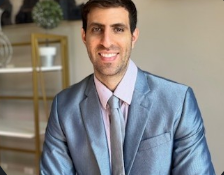
|
M.S. Systems Engineering | I'm currently in FSU's master's program in Systems Engineering. I'm an avid sports fan and enjoy working out. I spent my first 9 years as an engineer at Ford and currently work as an engineer at Bosch. I was motivated to pursue a Systems Engineering degree at FSU since I was new to the system engineering role. I plan to graduate in May 2026. | The Jacksonian Age - Leadership of a Polarizing President | Andrew Jackson is a prominent and polarizing figure in American history. Mostly known as the seventh President of the United States, Andrew Jackson held many leadership positions before his election to office. In a youth full of obstacles and hardships, Jackson overcame and persevered to become an influential figure in American politics. Jackson's leadership, characterized by his bold and often controversial approach, has left a lasting impact on American political history. His leadership style was rooted in his populist beliefs, military background, and strong-willed personality. Known for his decisive actions, he expanded presidential powers and advocated for a stronger executive branch, significantly altering the power of the presidency. Jackson's rise to prominence was fueled by his success in the Battle of New Orleans during the War of 1812, which shaped his reputation as a national hero. His presidency saw the implementation of policies such as the Indian Removal Act, leading to the forced relocation of thousands of Native Americans, and the dismantling of the national bank, which he believed to be a corrupt institution favoring the elite. Jackson fiercely advocated for the common man, yet his policies also provoked criticism for their authoritarian undertones and disregard for certain groups’ rights. While Jackson remains a polarizing figure, his leadership undeniably reshaped the presidency and left an indelible mark on the development of the United States. |
Dr. Daniel Georgiadis | College of Engineering | Industrial and Manufacturing Engineering | dgeorgiadis@fsu.edu | Leadership Traits of Andrew Jackson | Complete | 2025 | 5th annual Undergraduate Research Symposium, April 17, 2025 | https://pc.fsu.edu/student-research/symposium/research-symposium-program-portal?element_parents=elements/student_photo&ajax_form=1&_wrapper_format=drupal_ajax&token=DqC4jJ30Nyv7a7avNhjerNrB2vtPBFhchGO4FL2A_AI | |||||||
| 42 | 7711 | Asynchronous Online Presentation | https://pc.fsu.edu/student-research/symposium/symposium-program-2025/systems-engineering | Student Research Symposium Program Portal: Submission #42 | 9ec7ae45-9b64-4a0e-ac9b-a56ffe398b42 | No | Star/flag Student Research Symposium Program Portal: Submission #42 | Lock Student Research Symposium Program Portal: Submission #42 | Add notes to Student Research Symposium Program Portal: Submission #42 | Sun, 02/02/2025 - 04:44 PM | Sun, 02/02/2025 - 05:19 PM | Tue, 04/01/2025 - 07:57 AM | Anonymous | 172.72.75.61 | Megan | Langley | mel24e@fsu.edu |

|
Master of Science in Systems Engineering (MSSE) | I am currently pursuing a Master of Science in Systems Engineering (MSSE) at FSU, with plans to graduate in 2026. | Emily Roebling - Leadership Analysis | Systems engineers will address increased complexity and diversity of future systems. The infusion of systems thinking into complex system projects requires systems engineers to have technical and leadership competencies. Research was conducted on Emily Roebling, an engineering leader whose success exemplified systems thinking and technical leadership in a complex engineering project. During the construction of the Brooklyn Bridge, she played a pivotal role in overseeing its completion, effectively managing its technical and logistical challenges. Roebling applied systems thinking principles to the project, considering all interconnected components, coordinating across disciplines, managing stakeholder interfaces, and guiding teams toward optimal outcomes. Emily Roebling’s contributions as a technical leader in systems engineering were evaluated through a leadership analysis. The findings were then compared with major studies on systems engineering leadership and additional research perspectives on leadership. The goal of this research is to assess how Roebling’s traits, behaviors, and attributes align with established perspectives on systems engineering leadership competencies. |
Dr. Daniel Georgiadis | College of Engineering | Industrial and Manufacturing Engineering Department | dgeorgiadis@fsu.edu | Roebling, Systems, Engineering, Technical, Leadership | Complete | 2025 | 5th annual Undergraduate Research Symposium, April 17, 2025 | https://pc.fsu.edu/student-research/symposium/research-symposium-program-portal?element_parents=elements/student_photo&ajax_form=1&_wrapper_format=drupal_ajax&token=auLbIfi_ugboMrjJLdgqMhgPqBokf4ZpSqixFA71wJk | |||||||
| 41 | 7706 | Asynchronous Online Presentation | https://pc.fsu.edu/student-research/symposium/symposium-program-2025/systems-engineering | Student Research Symposium Program Portal: Submission #41 | 0c2a9a7a-a8ab-417c-896d-26d1b9263f22 | No | Star/flag Student Research Symposium Program Portal: Submission #41 | Lock Student Research Symposium Program Portal: Submission #41 | Add notes to Student Research Symposium Program Portal: Submission #41 | Sun, 02/02/2025 - 02:50 PM | Sun, 02/02/2025 - 03:03 PM | Tue, 04/01/2025 - 08:00 AM | Anonymous | 217.180.196.82 | Dominic | Garrett | dag20b@fsu.edu |
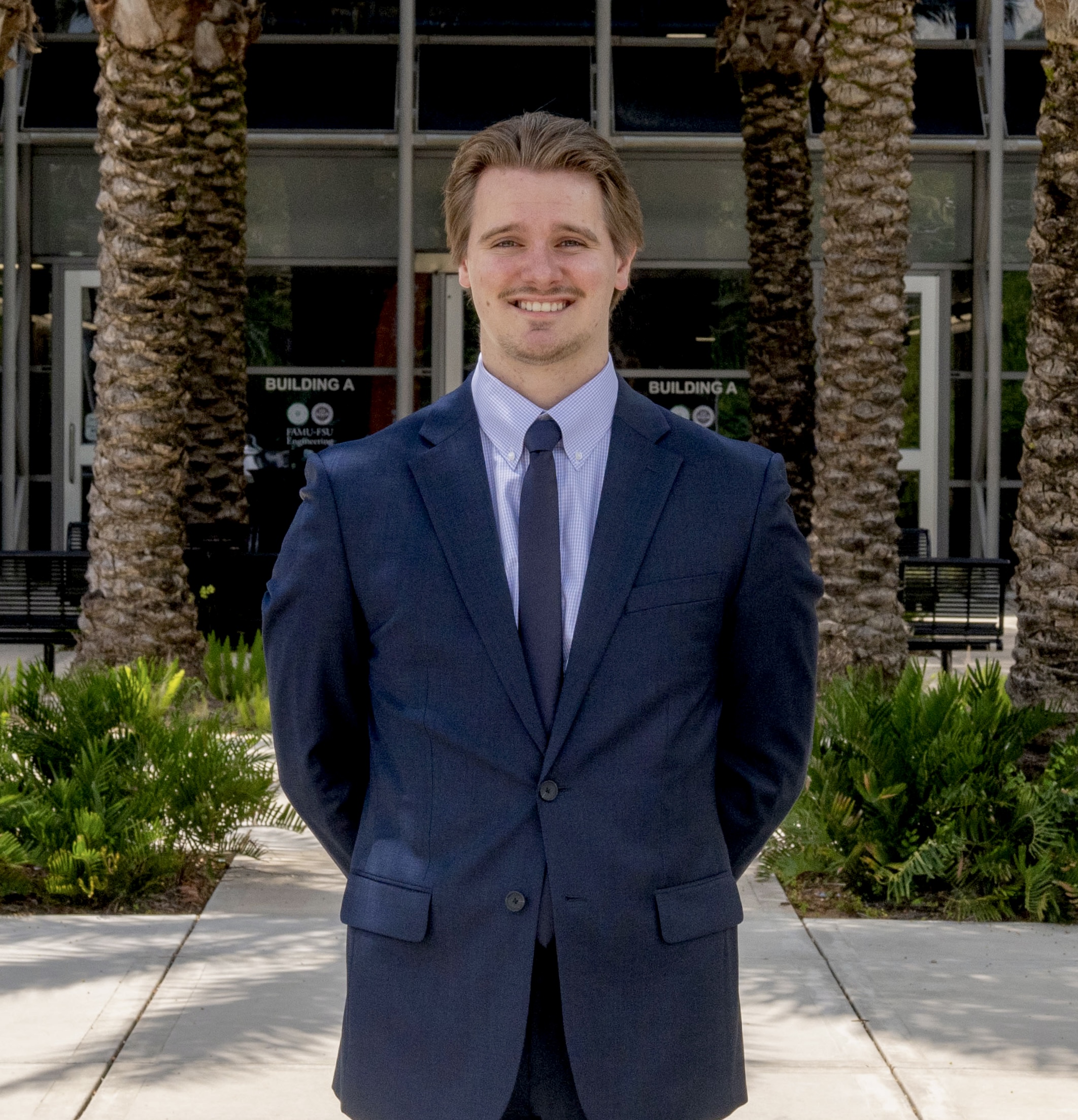
|
Chemical Engineering M.S. | I am a current graduate student at Florida State University slated to complete my M.S. in Chemical Engineering in Spring 2025. My baccalaureate success was marked by graduating from FSU’s honors college with the distinction of ‘Magna Cum Laude.’ My current academic success is illustrated by a 4.0 GPA, being amongst the top of my graduate class, while simultaneously leading undergraduate students in the program’s Chemical Engineering teaching laboratories as a teaching assistant. Throughout my studies, I have expanded my skillset in computational modeling for fluid dynamics and thermodynamics by employing Finite Element Analysis (FEA), both in advanced software (COMSOL) and through self-drafted regimes (MATLAB). I have developed expertise in process simulation and optimization through advanced study in computational software and hands-on laboratory experience. I aspire to join engineers in the further development of space technologies through advancing aerospace materials and propulsion systems with my engineering knowledge. | The Man Who Got Us To The Moon - James E. Webb | The visionary leader, James E. Webb, was the second administrator of NASA (1961–1968), whose visionary stewardship was instrumental in the success of the Apollo program and the advancement of space exploration. Webb’s ability to navigate complex political, technical, and organizational challenges enabled NASA to achieve the monumental goal of landing humans on the Moon. By fostering collaboration between government, industry, and academia, Webb ensured the Apollo program’s success and laid the foundation for modern space science and technology. Webb’s leadership principles, his legacy in shaping NASA’s culture, and the enduring impact of his work on space exploration and scientific discovery are still strongly engrained in society today, continuing to inspire engineers and scientists to pursue greater heights. | Daniel R. Georgiadis | FAMU-FSU College of Engineering | Industrial and Manufacturing Engineering | dgeorgiadis@eng.famu.fsu.edu | James E. Webb | Complete | 2025 | 5th annual Undergraduate Research Symposium, April 17, 2025 | https://pc.fsu.edu/student-research/symposium/research-symposium-program-portal?element_parents=elements/student_photo&ajax_form=1&_wrapper_format=drupal_ajax&token=aVJdOu-V3lASusIKUqM96AbAJapEoKGtAh-GbH9NBJw | |||||||
| 40 | 7701 | Asynchronous Online Presentation | https://pc.fsu.edu/student-research/symposium/symposium-program-2025/systems-engineering | Student Research Symposium Program Portal: Submission #40 | 91d02712-4044-42b0-b599-203329ab4eac | No | Star/flag Student Research Symposium Program Portal: Submission #40 | Lock Student Research Symposium Program Portal: Submission #40 | Add notes to Student Research Symposium Program Portal: Submission #40 | Sun, 02/02/2025 - 11:33 AM | Sun, 02/02/2025 - 11:59 AM | Tue, 04/01/2025 - 07:47 AM | Anonymous | 5.182.32.54 | Maj. Charles | Cousineau | clc09e@fsu.edu |
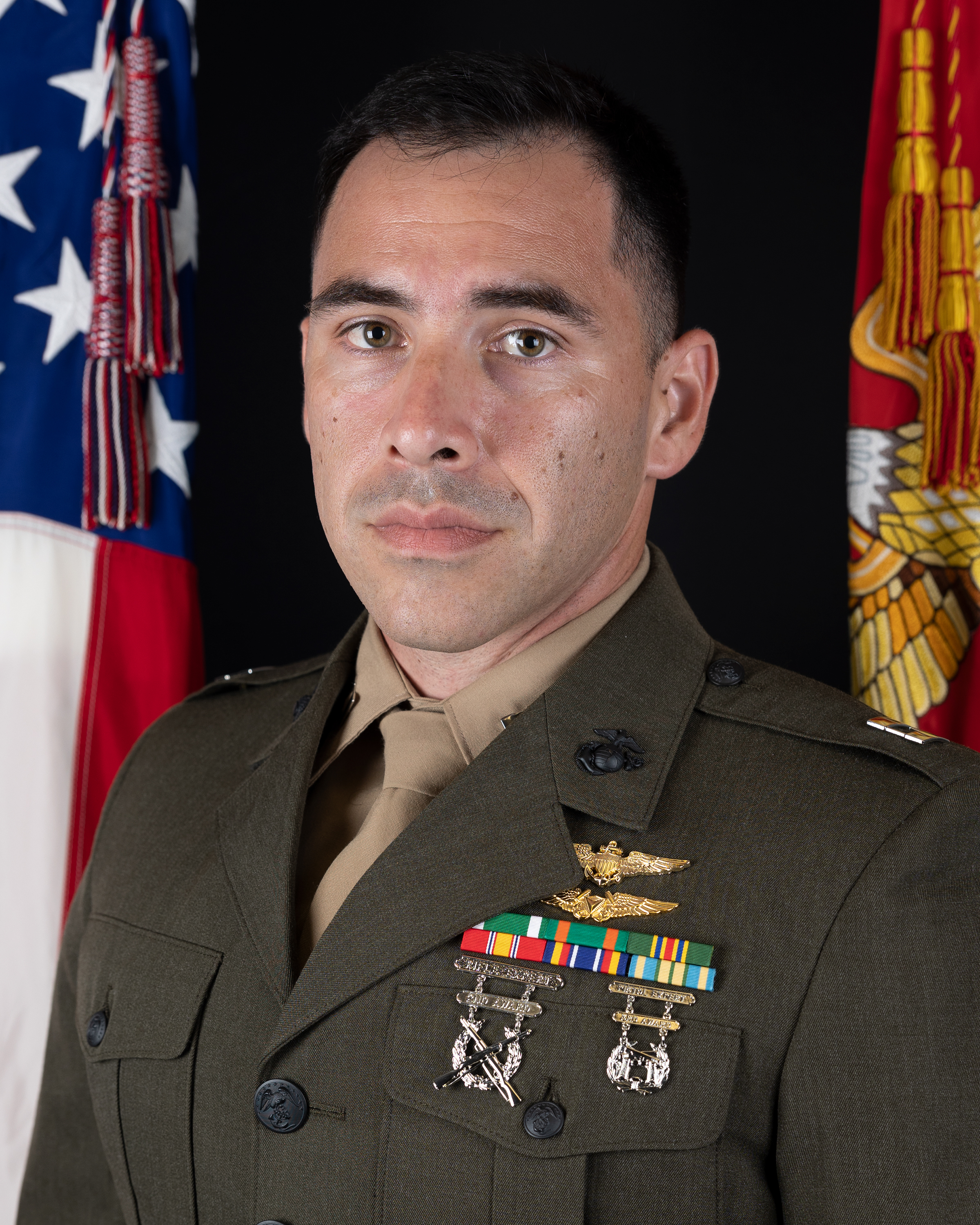
|
MS Systems Engineering | Major Charles L. Cousineau was born in Miami, Florida, and raised in Lima, Peru. He earned a dual B.S. in Mathematics and Economics from Florida State University in 2012 and was commissioned as a Second Lieutenant in March 2015. He completed The Basic School and earned his Naval Aviator designation in September 2017. Assigned to VMU-2 in March 2019, participated in two Deployments for Training, and led a maintenance department that excelled in inspections and readiness. In February 2021, he joined 2d Marine Division G-3, integrating Unmanned Systems, Counter-UAS, and Orbiting Precision Fires. He standardized the division’s Small UAS Program, co-authored the Marine Corps SUAS Reference Publication, and provided advanced SUAS training across II MEF, supporting the Marine Corps Infantry Battalion Experiment and standing up the Marine Corps SUAS Operator Military Occupation and its Training Schoolhouse. In July 2023, he became IRAS Division Head within Raider Support Group, overseeing MARSOC’s Unmanned Special Operations Capability Specialist (SOCS-U) program. He manages 30 SOCS-Us, advancing SUAS, GOPSS, UGV, and Counter-UAS capabilities. Captain Cousineau is pursuing a master’s in Systems Engineering. |
No Excuses Leadership: From the White House Door to the Global Stage. George C. Marshall’s Triumphant Path | George Catlett Marshall personified a “no excuses” brand of leadership. He combined an unbreakable moral backbone with fearless resourcefulness. Years before he shaped World War II strategy and the famed Marshall Plan, a young Candidate, Marshall, pushed open the literal door of the White House without an appointment, determined to secure a commission in a congested Army pipeline. That early act showed the same resolve that earned him a surprise standing ovation at Queen Elizabeth II’s coronation in 1953. From his audacious confrontation with General Pershing in World War I to reorganizing the entire U.S. Army for World War II, Marshall proved that speaking candidly and seizing initiative, even in rigid hierarchies, can transform crises into triumph. He championed rising talents like Dwight Eisenhower, demonstrated quiet integrity that gained the allies’ trust, and architected a postwar economic recovery that fused ethics with strategic planning. Using Uldrich’s nine Marshall principles and echoing them with the Marine Corps leadership ideals of moral courage, relentless adaptability, and unity of purpose, this presentation reveals how Marshall’s consistent “can-do” mindset and willingness to bypass obstacles can inspire modern leaders. His story demonstrates that genuine respect for people, bold initiative, and a higher moral calling can reshape one’s destiny from day one. |
Dr. Daniel Georgiadis | College of Engineering | Industrial and Manufacturing Engineering Department | dgeorgiadis@fsu.edu | Leadership George Catlett Marshall | Complete | 2025 | 5th annual Undergraduate Research Symposium, April 17, 2025 | https://pc.fsu.edu/student-research/symposium/research-symposium-program-portal?element_parents=elements/student_photo&ajax_form=1&_wrapper_format=drupal_ajax&token=wykPrUji0TalTkkCcTIfw7Bagt0vhtjBBm1gbSsKMJI |

